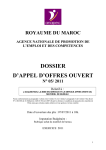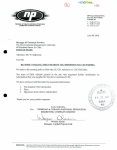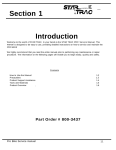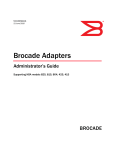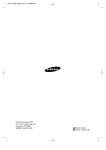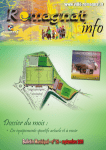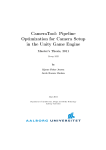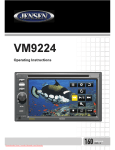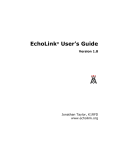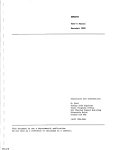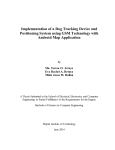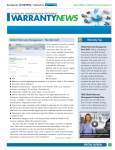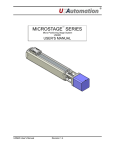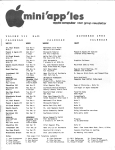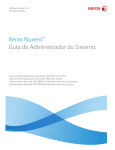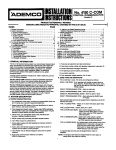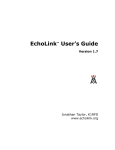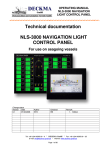Download 06. Response to Clarification Letter
Transcript
JJ
rneAlFiveS
e_
CEC 4135/2014
DOCUMENTS REQUESTED BY EMA IN THE FURTHER CLARIFICATION DOCUMENT SENT ON
APRIL 29TH, 2014.
Question 1 on Further Information:
In response to question 2 (Section A- General Information) of the CEC Application Form the
activity for which the CEC is required is:
43- Provision of other service oriented activities.
Definition:
(a) The establishment, modification, expansion, decommissioning or abandonment (inclusive of
associated works) of an automotive repair garage, autobody shops, gasoline/service stations or
vehicle inspection stations;
(c) The establishment, modification, decommissioning or abandonment (inclusive of associated
works) of a commercial kitchen with a water consumption of 9 cubic meters or more per day.
Activity 43( C ) is relevant to our development proposal because the Fast food outlet may
account for 0.38m3/day however the Supermarket will also be equipped with a bakery etc.
and there are other retail spaces that may account for water consumption and hence the
water consumption is expected to exceed 9 cubic meters or more per day.
Question 2 on Further Information:
Please see attached documents
Question 3 on Further Information:
Please see amended Mitigation Measures attached.
Question 4 on Further Information:
Please See attached for amended flyer and distribution list.
.- 29-2014 04:26 PM
2 2 MAY 201E1
how"
linrKETY. 102014
Our Ref. CEC4135/2014
April 23, 2014
Ramco Industries Limited
c/o Mr. lmtiaz Rahaman
No. 2 Shafik Drive
Cross Crossing
SAN FERNANDO
Dear Mr. Rahaman,
THE
APPLICATION FOR A CERTIFICATE OF ENVIRONMENTAL CLEARANCE (CEC413512014)
ESTABLISHMENT OF A MULTI-FUEL SERVICE STATION INCLUDING A COMPRESSED NATURAL
GAS RETAIL DISPENSING STATION, CONVENIENCE STORE, RETAIL SHOPS AND SUPERMARKET
AT THE CORNER of TISSUE DRIVE AND CHURCHILL ROOSEVELT HIGHWAY, TRINCITY
Previous correspondence on the captioned issue, ending with the response dated
March 24, 2014 to the Environmental Management Authority's (EMA's) request for
further information of March 04, 2014 refers.
d
March 24, 2014. The submitted
The EMA acknowledges receipt of this information on
information has been reviewed and it has been determined that clarification is require
arises from issues emerging
to enable the further processing of your application. This
from the information provided and Incomplete responses to our request. Please be
guided by the attached Request for Clarification of Further Information.
Should additional information or clarification be required, please contact the assigned
officer at 6453362 Ext. 4251.
Yours sincerely,
/f/ ENVIRONMENTAL MANAGEMENT AUTHORITY
MM/s1
8 Elizoboth Stsoot Si Clair, Port of Spaln, Trinidad
(808) 828-8042; 8044/5 Fox. (888) 628-9122. E-Mgastil:
1/Nilltt
APk-29-2014 04:27 PM
P. 02
Our Ref. CEC4136/2014
REQUEST FOR CLARIFICATION OF FURTHER INFORMATION
1.
The response to Question 1 of the Request for Further Information (RFD, which
required the Applicant to verify whether Activity 43(c) which is identified in the
CEO (Designated Activities) Order (as amended), is also considered to be within
the scope of the development proposal, indicated that Activity 43(c) is relevant.
However, the response to Question 2 of the RFI indicated that the anticipated
daily water consumption for the fast food outlet will be 0.38m3/day. In this regard,
it appears that Activity 43(c) may not be applicable to your development process.
As such, please verify the anticipated daily water consumption, in cubic metres,
of the fast food outlet/restaurant and supermarket. In addition, please confirm
whether Activity 43(c), as stated in the table below, is still relevant to your
development proposal.
ACTIVITY
43
2.
Provision of other
service-oriented
activities
DEFINITION
(c)
establishment,
modification,
The
decommissioning or abandonment (inclusive
of associated works) of a commercial kitchen
with a water consumption of 9 cubic metres
or more per day.
Question 10 of the RFI required the Applicant to provide information with respect
to the management of risk associated with the natural gas pipeline, and leaks
and/or failures of the CNG system, given the fact that there are residences and
businesses/industries within proximity to the proposed site. The response
provided gave the maximum volumetric capacity of CNG to be stored on the site
as 3200 litres, stored in forty 80-litre CNG cascade bottles. In addition, it was
also stated that the inlet pressure will be 143 psi and the discharge pressure
3600 psi.
However, a response was not provided with regard to a description of the
systems to be installed to minimise the risk of a fire or explosion on the site from
the piping, storage, compression and dispensing areas.
Question 10 also required the Applicant to provide a conceptual Emergency
Response Plan (ERP) to address emergencies, as well as all incidents and
accidents. In response, Appendix 11 entitled 'Emergency Response Plan' was
provided. This plan Identified the organization and structure of the emergency
response team, defining members' qualifications and roles, emergency response
procedures, and training of staff with regard to the ERR Further, the ERP
identified the Immediate neighbours of the proposed development and stated that
neighbours will he informed via telephone in the event of a fire drill.
1 of 4
APR-29-2014 04:27 PM
P. 03
Our Ref. CEC4136/2014
In addition, it was also stated that the Crisis Management Team will determine
the manner in which the emergency will be communicated to the surrounding
neighbours, and the provisions that will be provided to assist, where practical.
However, the conceptual ERP provided by the Applicant did not sufficiently
discuss the manner in which local residents and businesses/industries will be
contacted during an emergency, and what type of information will be
communicated to them. In addition, the plan to have proposed agreements with
the Tunapuna/Piarco Regional Corporation, Fire Service, co-operatives or
emergency response associations, to help deal with emergencies or adverse
situations, was not provided.
In this regard, please provide the following information:
4111
•
•
A description of the systems to be installed to minimise the risk of a fire or
explosion on the site from the piping, storage, compression and
dispensing areas;
•
A revised conceptual Emergency Response Plan (ERP) to address
emergencies, as well as all incidents and accidents. This conceptual ERP
should include the details already provided, and discuss the aspects
described below:
i.
The manner in which local residents and businesses/industries will
be contacted during an emergency and what type of information will
be communicated to them; and
ii.
A description of the planned procedures and equipment/resources
to be kept on the site for a tier I emergency, for example spills of
fuel;
The plan to have proposed agreements with the Tunapuna/Piarco
Regional Corporation, Fire Service, co-operatives or emergency
response associations, to help deal with emergencies or adverse
situations.
3.
Question 11 of the RFI required the Applicant to provide a detailed description of
the mitigation measures that will be implemented for fugitive dust and noise
generated during site preparation and construction and operational phases of the
facility, as well as potential impacts resulting from spills, leaks, etc. Appendix 8,
entitled 'Mitigation Measures', submitted in response to Question 11 identified
mitigation measures for fugitive dust and impacts resulting from spills, leaks, etc.
However, a statement with regard to mitigation measures to be implemented for
noise generated during the site preparation/construction and operational phase of
the proposed facility was not provided.
2 of 4
OR-29-2014 04:28 PM
P. 04
ti
Our Ref. CEO/1135/2014
As such, please provide a description of the mitigation measures that will be
implemented for the anticipated potential significant adverse impacts associated
with noise generated during the site preparation/construction and operational
phases of the proposed facility.
4.
Question 12 of the RFI required the Applicant to inform the neighbouring
residents of the proposed activity. In response, a copy of the flyer which was
distributed to neighbouring receptors was provided. The submitted copy of the
flyer included the following information:
-
The CEC reference number;
A description of the proposed activity;
Nature and precise location of the project;
Activities to be undertaken, as well as the scheduling and duration of
activities on the site;
The distribution list with the names, addresses, time of receipt of flyers,
comments and signatures of persons receiving the flyers;
•
However, the submitted copy of the flyer omitted a summary of the anticipated
potential significant adverse impacts associated with the activities to be
undertaken at the site (for example, fugitive dust, noise, emissions associated
with venting of underground storage tanks, water contamination, runoff and other
similar nuisances), and mitigation measures to reduce such impacts. In addition,
the distribution list did not include any evidence that neighbouring residents
located to the east of the facility (i.e. along Orange Grove Rdad) were informed
about the proposed development.
In this regard, given the nature of this activity, the EMA requests that the
neighbouring residents and businesses/industries and other potential
stakeholders be informed about the proposed project and given the opportunity to
share any opinion of the proposed activity. As such, please provide a copy of the
amended flyer and complete distribution list, with the names, addresses, time of
receipt of flyers, and comments and signatures of parties receiving the flyers
Please be advised that the information requested above must be submitted in triplicate
to the EMA for an assessment to be made of the application.
If deemed necessary, the Applicant may request a meeting with the EMA to clarify any
outstanding concerns surrounding this application. Please contact the assigned officer
to arrange such meeting.
3 of 4
•
ePR-28-2014 04:28 PM
P. Ub
Our Ref, CEC4135/2014
NOTE:
To facilitate the processing of this application, all correspondence must be labelled
Further information, indicating the relevant CEC Reference Number, and should be
addressed:
ATTENTION:
Manager - Technical Services
Environmental Management Authority
#8 Elizabeth Street, St. Clair
P.O. Box 5071
PORT-OF-SPAIN
NB: An addressed label relative to this application is enclosed for your response.
4 of 4
Agra
•
GaS lazy'
Modclo Aprebado
lAtE,R1 MASI
•
AGIRA KNOX TP 130 3 STAGE
ELECTRICAL ENGINE
CNG COMPRESSOR
Revision Date No. 0.
th
Wednesday, February 6 , 2012.
AGIRA SA.
Ruta Panamericana Km 30 — No. 30048 — Colectora Geste
(1617) Pacheco - Buenos Aires
ARGENTINA
Phone: 541163340000
Fax: 541163340011
www.aeira.com.ar
File mainserver (Z) \Compartido \Olsen() Industrial NanualeskAGRA KNOX TP 130 \Manual TP 130 3 ETAPAS
CONTENTS.
1. INTRODUCTION
2. COMPRESSOR DATA
2.1 - Technical Specifications.
2.2 - Technical Features.
2.3 - Base Support.
2.4 - Loading and Unloading.
3. GAS CONNECTIONS
3.1- Technical Data.
3.2- Descriptive Drawings
4. ELECTRICAL CONNECTIONS
4.1- Main Engine.
4.2- Fan Engine.
4.3- Electrical Panel
4.4- Compressor Panel
5. OPERATION
5.1- General Considerations.
5.2- Start Sequence.
5.3- Stop Sequence.
5.4- Emergency Stop.
6. MAINTENANCE
6.1- Lubrication.
6.1.1- Oil.
6.2- Radiator Cleaning.
6.3- General Inspection and Maintenance.
6.4- Pneumatic Shock Absorbers.
6.5- Power Cut Prevention.
7. FAILURES: DETECTION AND CORRECTION.
8. DRAWINGS
8.1- Connections. drawing No. 8-0830 A - I (Rev. 0).
8.2- Compressor Electrical Panel. drawing No.9-0232 U (Rev. 0).
8.3-Compressor electrical wiring. Drawing No. 8-0910 A (Rev. 0)
•
•
REVISIONS:
Rev. No.
Description
Date
Revised
CAUTION
" READ CAREFULLY THE FOLLOWING MANUAL BEFORE START UP THE
MACHINE"
THE COMPRESS GAS UNITYS ARE COMPLICATED AND DANGEROUS
MACHINES, FOR THE PEOPLE THAT DON'T HAVE THE TRAINING AND
ACQUAINTED WITH IT FUNCTIONS
BEFORE STARTING THIS UNITS:
1_ READ AND STUDY START-UP AND SHUT-DOWN INFORMATION FOR BOTH
PACKAGE AND COMPRESSOR CAREFULLY.
2_ A GAS/AIR MIXTURE UNDER PRESSURE CAN EXPLODE! YOU CAN BE
SEVERELY INJURED FOR KELLED. MAKE SURE THE COMPRESSOR IS
SUFFICIENLY PURGED OF ANY EXPLOSIVE MIXTURE BEFORE LOADING.
3_ AFTER COMPLETING THE ABOVE, BEGIN PROPER STARTING PROCEDURE.
CAUTION
DO NOT ATTEMPT TO START-UP UNIT WITHOUT REFERING TO THIS
MANUAL SECTION 5.2 "START SEQUENCE" AND 5.3 "STOP
SEQUENCE". IT IS ALSO ESSENTIAL TO REFER TO THE PACKAGER'S
OPERATING MANUAL.
"DO NOT MAKE ANY TYPE OF MAINTENANCE OR REPAIR WORK WHEN
THE COMPRESSOR IS OPERATING"
"THE NATURAL GAS COMPRESSOR IS POTENTIALLY DANGEROUS SO
IT HAVE TO BE MANAGE BY QUALIFIED PERSONAL".
USER'S MANUAL
AGIRA KNOX TP 130 3 STAGE
ELECTRICAL ENGINE
CNG COMPRESSOR
1- INTRODUCTION:
This manual aims to provide the user with all the information regarding:
Installation, Start up, Operation, and Maintenance of the AGIRA KNOX TP 130
3 STAGE CNG compression unit, as well as all technical and functional features
of this unit.
Therefore, we ask you to read it carefully to assure proper use and maximize
performance of the equipment.
•
2- COMPRESSOR DATA
2.1- Technical Specifications:
Feed: 3x440V — 60Hz
RPM: 1780
Approx. Weight: 8000 KG.
External Measures (mm): width 3125, height 2650, length 2250.
Oil sump capacity: 8 Lts.
Maximum working pressure: 3000 PSI (200 Bar).
2.2- Technical Features:
Number of Stages: 3.
Cylinders: 3.
Maximum suction pressure: 200 PSI (14 Bar).
Minimum suction pressure: 300 PSI (21Bar).
Power: 150 HP.
3
Performance: 630 CFM (1000 Nm /h) at 300 PSI
2.3- Base Support:
The compressor installation site shall comply with the environmental
safety rules in force, according to IRAM Standards No. 4062. The floor
must be made of concrete to support the weight of the equipment without
breaking.
AGIRA KNOX TP 130 3 STAGE compressors have an Exclusive
System of Four Pneumatic Supports designed to substantially
diminish vibrations and, therefore, prevent them from reaching
equipment or facilities close to the compressor. The location of shock
absorbers in the equipment can be found in figure No. 1.
2.4- Loading and Unloading:
A crane must be available to place the equipment for its loading and
unloading at the installation site. The crane must be able to move the
equipment, on site, without risks of accidents.
The compressor must be attached to the crane by means of a hoisting
device, as shown in figure No. 2.
•
FIG. No. 1.
rA
L.—a
•
FIG. No. 2.
•
t.
k s
1 ... 0
CAUTION
"FLATTENING HAZARD". IT EXPRESSLY FORBIDDEN THAT ANY OPERATOR
PLACE UNDER THE COMPRESSOR DURING THE RAISE OF IT, SO YOU HAVE TO
ALERT AND DELIMITATE THE ZONE.
CAUTION
THE OPERATOR CAN ONLY PLACE NEAR THE COMPRESSOR WHEN THIS IS IN
THE HORIZONTAL TRANSLATE, UNDER 500MM OF THE FLOOR.
CAUTION
BEFORE PROCEED TO THE COMPRESSOR RAISE YOU HAVE TO CHEK OUT THE
HOOKS, SLINGS, AND YOUR CHARGE CAPACITIES AND THE CRANE.
CAUTION
ONLY YOU CAN RAISE THE COMPRESSOR HOOK UP FROM THE 4 HOLES THAT
ARE SITUATED IN THE SKID BASE
ATENCION
BEFORE ANY OPERATION OF THE COMPRESSOR, LIKE ASSEMBLING, RAISE;
REPARATIONS OR MAINTENANCE. THE OPERATOR SHUOLD CARRY THE
FOLLOWING INDIVIDUAL SECURITY EQUIPMENT; GLOVES, SECURITY BOOTS
(WITH REINFORCED TOECAP, ADEQUATE CLOTH
3- GAS CONNECTIONS
S
3.1- Technical Data
The piping of gas connections from the network to the equipment shall
be performed by the company to be determined, while AGIRA S.A. shall
provide the technical specifications regarding the piping.
3.2- Descriptive Drawings
See Drawing No. 8-0830 A-I (Rev. 0) at the end of this section, which
provides details on the connections and their distributions.
4- ELECTRICAL CONNECTIONS
All connections involving the compressor must be taken into account, according
to drawing No. 9-0013 U (Rev. 0), which describes all the characteristics of the
wires for the connection, as well as the arrangement of the electrical control
panel provided by AGIRA S.A.
•
4.1- Main Engine:
Features:
Electrical Engine: WEG.
Power: 150HP.
RPM: 1780.
Feed: 3 x 440V — 60Hz
Class 1 Div. 1 APE electrical protection (FCXP).
4.2- Fan Engine:
Features:
Electrical Engine: WEG
Power: 7.5 HP.
RPM: 1180
Feed: 3 x 440V — 60Hz
Class 1 Div. 1 APE electrical protection (FCXP).
4.3- Electrical Panel:
The electrical panel consists of a "Command / Electricity inlet
panel for a soft start".
The command / electricity panel is formed by:
Cabinet 600x900x340mm.
P.L.C.: designed to carry out the starting up and stopping in a
programmed way.
Intrinsic-safety terminal: receives information from the PLC of the
different control instruments. In turn, it sends a signal to a terminal and
this terminal sends it to the compressor's Murphy panel, where the
manometer and temperature indicators are installed.
This way, it operates under anti-explosive conditions complying with
safety standards.
In addition, the panel is formed by two 6 Amp. thermal keys to feed the
PLC and 24 VCC source, and one 20 A three-pole thermal key to feed
the fan, a fan engine guard, the PLC Feed source, and a fan Contactor.
Indicating display (allows the viewing of all compressor operating
parameters), alarm Buzzer, compressor's stop Signal and Start Key.
And a 400Amp disconnecting key with fuse blocks, three
ultra-rapid 400 A fuses, and a weg soft start. It is designed to control
power consumption during the start of the equipment, avoiding excessive
power consumption.
The arrangement of the parts in the command panel/ electricity can be
found in drawing No. 9-0232 U (Rev. 0).
4.4- Compressor Panel:
This panel aims to show the Pressure and Temperature operating
parameters of the compressor, by means of WIKA instruments located
therein. Such instruments work through signals issued by the
intrinsic-safety terminal, therefore, the panel's operating conditions are
anti-explosive, avoiding any kind of accident.
At the bottom has a start Key and an emergency Switch, for the event of
emergency stops. See Fig. No. 4.
NOTA:
2
3
eD
4
5
6
0
FIG. No. 4.
a-
7
1-PRESION ENTRADA AL COMPRESOR: 0-1500 PSI
2-PRESION 1 ° ETAPA: 0-3000 PSI
3-PRESION 2° ETAPA: 0-5000 PSI
4 TEMP. 1° ETAPA: 0-350°F
5-TEMP. 2° ETAPA: 0-350°F
6- PARADA DE COMPRESOR
7- LLAVE DE ARRANQUE COMPRESOR
S
5 — OPERATION
5.1- General Considerations:
Agira KNOX TP 130 3 STAGE compressor is powered by an electrical
engine. It will be operated by a Telemecanique TWIDO P.L.C., where a
specially designed program is installed, with a specific sequence,
mentioned below.
The P.L.C. is linked to a display, which indicates, through labels, what is
happening in the compressor at that moment. It indicates the starting
sequence, normal stop and different failures for emergency stops.
The compressor panel has a start key, emergency stop and alarm
buzzer.
Tension signals (220 V) leave the P.L.C. to feed the inverter of the main
engine and the solenoid valves operating in the different command
actuators of the compressor. There are also intrinsic safety signals
leaving the P.L.C, which are linked to the compressor panel with respect
to emergency stops and command signals.
The electrical engine starts by means of a inverter, which is mounted on
the same panel.
5.2- Start Sequence
The compressor may be started by pushing the start key that is located
in the remote panel or compressor panel (Fig. 4) in the compressor. The
start procedure is performed by moving the key of the panel to RESET
position and then to START position. At this time the compressor will
start running. If it does not, check the message appearing in the Display
in order to troubleshoot the failure (see failure details).
The start is carried out as follows:
1) The P.L.C. sends the required electrical signal so the inlet valve opens
and the fan starts (Y1 and Y4 outlets of terminal B2). After four (4)
seconds, the P.L.C. sends the required electrical signal to initiate the
inverter (Y8 outlet of terminal B2), and likewise starts the compressor.
The phrase "COMPRESSOT STARTING", and, later, the expression
"COMPRESSOR RUNNING" will appear on the display.
2) Once the start-up ramp is finished (estimated in 12 seconds: a
value that is set in the soft starter), the solenoid that controls the
depressurization valve (Y3 outlet of terminal B2) starts running, closing
this valve and starting compression. The phrase "Compressing" will
appear on the display.
The controller will check, at all times, that every variable is working
properly.
The abovementioned times are entered into the program by AGIRA S.A.
personnel during the implementation.
5.3- Normal Stop Sequence:
When the compressor reaches its maximum discharge pressure (200
th
bar), the 3 stage manometer switch will send a signal to the P.L.C.,
which will cause the latter to start the stopping sequence described
below:
1) The inlet valve (Y1 outlet of terminal B2) is closed. The engine keeps
rotating, which will cause the existing gas to be consumed in the inlet
tank, and the consequent inlet pressure drop. The phrase
"COMPRESSOR STOPPING " will appear on the display.
2) When pressure reaches approximately 1 Bar, the compressor
will stop. Said configuration is set by AGIRA personnel by modifying, in
the program, the time the compressor will take to stop after the valve is
closed.
3) Once the compressor stops, the pressurization valve (Y3 outlet
of terminal B2) opens, and, as said valve is connected to the inlet Blow
Down pipe, pressure is equalized in all stages. The equalized pressure,
which will be almost equal to the suction pressure, will leave the
compressor ready for the next start. The words 'READY TO RUN" will
appear on the display.
th
The P.L.C. waits for the 3 stage manometer switch signal. When
storage pressure drops to 180 bar, the compressor will re-start the
sequence.
5.4- Emergency Stops
In case some of the controlled parameters are, momentarily, with a value
off the normal operation range, the instruments will send a signal to the
P.L.C., which will cause the compressor to stop.
The following are the emergency stop parameters:
COMPRESSOR OIL PRESSURE LOW
OIL LEVEL LOW
INLET PRESSURE LOW
INLET PRESSURE HIGH
St
1 STAGE PRESSURE HIGH
nd
2 STAGE PRESSURE HIGH
nd
1 STAGE GAS TEMPERATURE HIGH
St
2 STAGE GAS TEMPERATURE HIGH
rd
3 STAGE GAS TEMPERATURE HIGH
MAIN MOTOR OVERLOAD
FAN MOTOR OVERLOAD
EXCESS OF VIBRATION
LUBRICATION FAULT
EMERGENCY STOP
These are the messages that can be viewed on the display in case of
failure.
CAUTION
IT COULD CAUSE SERIOUS PERSONAL HURTS AND MATERIAL
DAMAGES IF IT IS NOT FULLY DISCHARGE THE SYSTEM PRESSURE
BEFORE DROP THE PINS IN THE BRIDLES, BUTTS, VALVES COVERS OR
GASKETS.
ANY MAINTENANCE WORK HAVE TO BE DONE BY QUALIFIED
OPERATOR.
CAUTION
THE NOISE OF THE COMPRESSOR COULD CAUSE DAMAGE IN THE
EARS.
USE EAR PROTECTION WHE THE EQUIPMENT IS WORKING.
BEFORE STARTING ANY MAINTENANCE OR REMOVING ANY
COMPONENTS, RELIEVE ALL PRESSURE FROM THE COMPRESSOR
CYLINDERS. (TO VENT ALL THE SYSTEM, OPEN THE PURGE VALVE OF
THE BLOW DOWN)
AFTER PERFORMING ANY MAINTENANCE, THE ENTIRE SYSTEM MUST BE
PURGED WITH GAS PRIOR TO OPERATION, TO AVOID A POTENTIALLY
EXPLOSIVE AIR/GAS MIXTURE.
CAUTION
TRAPPED GAS PRESSURE CAN PRESENT A PERSONAL SAFETY HAZARD
HEN YOU MAKE SOME TECHNICAL SERVICE.
WORK IN A WINDY AREA AND FREE OF SPARK.
DO NOT BREATHE GAS WHEN YOU VENT
6- MAINTENANCE
6.1- Lubrication: See Fig. No.6
Lubrication is vital for the good operation and long useful life of the
compressor and, therefore, requires special care since the equipment
operates under high Pressure and Temperature conditions, which could
jeopardize some of the equipment's mechanical parts.
Note that a good lubrication will allow:
A) Reduction of mechanical friction and, therefore, power
consumption.
B) Reduction of wear and tear: by increasing the operational life of
the equipment and, consequently, reducing maintenance costs.
C) Prevention of corrosion in contact parts.
D) Maintenance of friction surfaces in good conditions, allowing
work under mechanical tolerance conditions.
The lubrication system is designed for such purpose; therefore, the
operator will have to bear the following considerations in mind:
6.1.1- Oil:
Features: Mineral oil SAE 40
Control:
Amount of oil in sump: 8 Lts.
Oil Change: every 1000 hours.
Filter Change: every 1000 hours.
Oil level in compressor viewer.
"OIL LEVEL" INDICATOR
FIG. No. 6
% MAX
'A MIN
CAUTION
ADD OIL WHEN IT IS NECESSARY, TO KEEP OIL LEVEL BETWEEN THE
MAXIMUM AND MINIMUM INDICATED.
THE OIL LEVEL MUST BE CHECKED WITH THE COMPRESSOR RUNNING.
CAUTION
VENT THE BLOW DOWN 2 OR 3 TIMES PER DAY.
DO NOT REUTILIZE THE OIL EXTRACTED FROM THE PURGE.
6.2- Radiator Cleaning
The cleaning of the radiators is very important for proper operation of the
compressor (heat exchangers GAS-AIR).
Therefore, pressurized air must be injected (upstream) weekly,
preferably with the fan running, in order to eliminate the dust or any other
material that can stick to the diverter plates of the heat exchanger. This
will increase its efficiency and thus produce an outlet gas at room
temperature.
CAUTION
THE HOT COMPRESSED GAS TEMPERATURE SPECIALLY FROM THE
DISCHARGE AREAS IN THE CYLINDERS AND IN THE FRICTION AREAS
COULD CAUSE IMPORTANT BURNINGS.
TURN OFF THE UNITY AND LEAVE IT CATCH COLD BEFORE MAKING
MAINTENANCE WORKS IN THOSE AREAS.
CAUTION
"THE COUPLING PROTECTOR MUST BE ALWAYS IN ITS POSITION, FOR
SAFETY REASONS".
"NEVER START UP THE COMPRESSOR WITHUOT SET UP THE
COUPLING PROTECTOR".
"IT IS FORBIDEEN TO EXTRACT THE COUPLING PROTECTOR BY A NOT
QUALIFIED OPERATOR FOR THE MAINTENANCE OF THE COMPRESSOR
WITHOUT THE PREVIOUS DESCONECTION OF THE FEEDING
FOUNTAIN".
0
6.3- General Inspection and Maintenance
CONTROL
Control Compressor
Oil Level
Manually Drain the
Condensate of
Separators
Perform a Visual
Inspection to Detect
any Oil or Gas Leak
Control Hot Oil
Pressure (35 to 40
Psig.)
Control Unusual
Vibrations
Record All Pressures
and Temperatures in a
Daily Notepad
Clean Heat Exchangers
Gas-Air
Change Oil (8 Lts.)
Normal SAE 40
Supervise that all the
stops of the machines
are working
Change Oil Filter
Control all machine
locks
Check measurement
instruments
Test pipe sealing
Verify sensitivity of
vibration sensor
Check rings in all
stages (Change if it
necessary)
Change rings in
last stage.
DAILY
EVERY
15
DAYS
EVERY
1000
HOURS
EVERY
4000
HOURS.
Yes
Yes
Yes
Yes
Yes
Yes
Yes
Yes
Yes
Yes
Yes
Yes
Yes
Yes
Yes
Yes
EVERY
8000
HOURS
EVERY
16000
HOURS
EVERY
32000
HOURS
CONTROL
DAILY
EVERY 15
DAYS
Change packings on
both sides of
compressor
Change valves of all
stages
Change of metal lever
link - crankshaft
Change crankshaft
bearings
Change Cross-Head
Bushings
Replace 0 rings and
joints
Check oil pump to
gears. Change if
necessary
Verify rods and pistons
of all stages (change if
necessary)
Verify light (wear and
tear) between
cross-head and
cross-head guide
EVERY
1000
HOURS
EVERY
4000
HOURS.
EVERY
8000
HOURS
EVERY
16000
HOURS
EVERY
32000
HOURS
Yes
Yes
6.4- Pneumatic Shock Absorbers
Verify that the Pneumatic Shock Absorbers always maintain air pressure so that
the compressor never makes contact with the floor, and remains at a minimum
distance of 50 mm. Otherwise, blow shock absorbers up with compressed air at
10 Bar (Max), so that the compressor is leveled in all directions.
6.5- Power Cut Prevention.
In case of a power outage in the CNG station, all thermal magnetic keys of the
compressor feed, PLC, Suppliers and Emergency Stop must be disconnected.
Once electric power is reestablished, all thermal keys must be reconnected. In
this case the Emergency Stop will remain active, for which the reset button of
emergency stop must be pushed, then a light signal will turn off and the power
supply will be reinstated for normal operation.
NOTE: If you have an emergency power generator, the operation must follow
these steps:
1- Disconnect all thermal keys.
2- Connect the Emergency Power Generator.
3- Connect all thermal keys slowly, one at a time, until all of them are
opened.
Yes
Yes
Yes
Yes
Yes
Yes
Yes
CAUTION
IN THE CASE OF ELECTRIC MAINTENANCE DICONECT THE MACHINE
OF ALL ELECTRIC SUPPLY.
CAUTION
THE ACCES TO THE ELECTRIC ZONES ARE INDICATED WITH A
ETIQUETTE OF DANGER WITH A DRAWING OF A THUNDERBOLT.
"ALL ELECTRIC INSTALLATION OF THE PLACE WERE IS GOING TO
BE THE COMPRESSOR SHOULD BE "APE" EXPLOSION PROOF".
•
CAUTION
THE EMPLACEMENT OF THE COMPRESSOR WITH THE ELECTRIC
PANELS SHOULD GOES IN A PROTECT ZONE OF HUMIDITY AND THE
TEMPERATURE OF THE EMPLACEMENTS MUST BE LESS THAN 50°C
•
7- FAILURES: DETECTION AND CORRECTION.
POSSIBLE CAUSE
SOLUTION
FAILURE
Inlet pressure low
Outlet fuse Vi (terminal B2) may
be broken.
Change fuse.
The coil of three-way Skinner valve
is burnt (short circuit).
Call Technical Service.
The three-way valve does not
work properly (does not move the
actuator).
Call Technical Service.
The servo control valve of the
measuring bridge is closed.
Check electrical power and its coil.
Compressor oil
pressure low
Oil leak in the circuit
High viscosity oil at low
temperature.
Excess Vibration
High sensitivity of vibrations
sensor.
Visual inspection of oil circuit. If
there is any leak, tighten
connectors.
Start compressor again (just once)
and verify that oil pressure
increases.
Remove sensitivity from sensor.
Turn sensitivity knob towards LESS
side, one division of the scale.
Set the vibration sensor properly.
Vibration sensor is loose.
High inlet pressure
Verify inlet pressure within normal
values (8 bar).
1st stage
Pressure high
Suction valve in 2nd stage is
broken.
Call Technical Service.
FAILURE
2nd stage
Pressure high
Gas temperatura
high
Fan motor
POSSIBLE CAUSE
SOLUTION
High inlet pressure.
Verify inlet pressure within normal
values (8 bar).
Suction valve in 3rd stage is
broken.
Call Technical Service.
Outlet fuse Y4 (Terminal B2) may
be broken. Fan does not work.
Change fuse.
Contacts of contactor are broken.
Fan does not work.
Call Technical Service.
Inter-stage radiators are dirty.
Clean radiators externally with a
hydraulic pressure washer
Failure of motor guard (red button
on).
Verify phases and stretching
differences among phases. Press
BLACK button (START) in motor
guard.
Short circuit in motor
High electric current(verify)
overload
Verify continuity among motor coils
and earth.
Main motor
Inverter failure
See soft start manual and proceed
accordingly
Y3 Outlet fuse (Terminal B2) may
be broken.
Change fuse
overload
Display indicates
compression but it
does not increase
inter stage
pressures
The coil of three-way
depressurization (Skinner) valve is
burnt (short circuit)
Three-way valve does not work
properly (it does not move the
actuator)
Call Technical Service.
Call Technical Service.
8- DRAWINGS:
8.1- Connections.
201
UI
OESCIIPION
r
6
AGIRA KNOX COMPRESSOR3/4ETAPAS
raw
I
DIMENSIONSANDCONNECTIONS
008R..
0
2O1
7A5
• Wd•qaw4e+DIm'ew.ure. /dm
WyWDeumlu. Vs W.* io 4a 4s pdal
NI Paws* , am X" W Vs Figack7
8.2- Compressor Electrical Panel.
0
nn;:a
R8g6Rnlart3cc5r.6....,
rc
C
lIa
Igq
1111111111111111HHIIIHIHHHH11111111111HHOHUH
CV
O
0
CE
0
llllll UHUIHHHHHHHHHUHHHHHUHUHHEIHUHlill
Z
<
111111111111111111111111111111111
HHHHIMIHUH
UHUIIIIIIIIHHHUHUMIHNHUHH
•
Eco,4
1-11,
0 00
MI<
Z 1°10
R
If
Iif
unmyr.%:41mr.na
Is I
3
r :
o a
0
1—
M 0
<0
0
W 00
W W0
WW
m
MO
mM
I
0 o5
0 0
hi li
0
00 0 0M
111
iii
2
I I
111111111111111111HOHUHUHHIIHIHHHHHIM
1111111111111111111111111111111
UIIIHMUHI
.::1111111111HHUHUHHHHHHHUUR
I
2:2R ss:rr gl RUniii292;"
att
av
a
818
555 Ig
•
a
4001.24we mow
suawa
WV I* Ida a 3. sleulaxt
c*.s .0VSOp
r■ IS war m4f,),7
8.3- Compressor Electrical wiring
-0°1cc
Lu,....
0 cpcc
L,,v.'
03
•iilL,
Mcc
< IL
0-
vi
8-0010 A
t
i.
1
1
.
5 1=2<
zo
»x
g
_
,g
ig
§
,
Ve
1.
as
RECRICALWIRIVG
l-./,
ts., ..L.)- 1.
) d-0
d-,y,
1
1
.
er
I-cow
Cr Cs.1 0
Louz
i-mLuacc
1;-_,
=
r'ig
.,.. ..,
'7,
E
i-
t
e
1.1•17Ilr
c..)
i
F.
.
.
`1 i
^
.
isi
;.
.E
0)
C
CCill a03
., .
‹
...,,.,
L
Z
o0 0
00
0
a
:
i
co 111
Lu
z g
2
CC
71
Lu 0..
0 .5,
1.
'-a.
o
o
c.
o
0
<
9
2
F
0
.-4
111
1 !: 1
(§)-
.3
E.-, z
a
a
Cz.. o
o ,i
cnoI
,4
0
-2 W
E-, 0
rza lil
m
(=1CC
-.-,
ti
La
ra-§
4
i.c
§
cc
-
W
M
8-5
rii
Eo
._
c:,
'cT
gl
El
-g '0k's''\ \I/ 2.-
W
-2
(9
Z
r
w
t
•F
=c
m a: :
>
z
z
1-
•'
i
0
..,
cn
rz-1
C4
a.
<
u
o„
1
.e'Fs
2
tn
U)
z
oo
ii
i
.g
...0
1
cuE
e
v
xxx a
l'o-1
r.
—.
x
.
0i
u_
§. 1
5
w o .
c
. u,
cc 0 t-. ;
2 Ua rii
ec LT, 16,' '=. .
L
To ca .,.='_ 0 >
- 0 m
0 .1. a.)i I-t 01
u)
u.1
Ii
i
_a
10
-1Ew
‘r 1<
to
tu 10
E
0
0
L
..,a
A'
z. -E
.,
a
2
-.u7, §
E
A
a I0o
0z
o
cc10o-u.
11.1 1.11
`2 Lc
1-0
o I.al
u
.Lcr
im
1- Cr w0
2`g
:.,......7,0,.....;:„=:.---ii.•;
Description of CNG Systems to be installed to reduce the risk of Fires or Explosions:
CNG Storage System
1. The cascade having horizontal cylinder and site of parallel to other cascade, cylinder fittings
would be arranged so that they do no face cylinder fittings of other cascade.
2. Cylinder installed horizontally in a cascade will be separated from another cylinder in the
cascade by a distance of not less than 30mm.
3. Cascade with horizontal cylinders will have the valves fitted on the same side within the
cascade opposite to the refuelling point and arranged in a manner that any gas leakage is
discharged upwards.
4. Cascade units will be installed on a firm, compacted, welldrained non-combustible foundation.
This foundation may be in the form of a plinth with the raised edge at 2M from the front and
sides of the cascade forming a kerb up to which vehicles should be permitted. The cascade will
be securely anchored to prevent floating in case flooding is anticipated.
5. Gas storage facility will be protected from the effects of the weather by a roof or canopy
designed to facilitate the dispersion of free escaped gas and shall not permit gas to be trapped.
6. Adequate means will be provided to prevent the flow or accumulation of flammable or
combustible liquids under containers such as by grading, pads or diversion curbs.
Cylinders
1. The cylinders and their fittings for CNG use will be designed, manufactured, tested including
hydrostatic stretch test a pressure in full conformity
2. These cylinders will be permanently and clearly marked for "CNG only and also labelled CNG
only" in letter at least 25mm high in contrasting colour in a location which shall be visible after
installation.
3. The cylinder will be fabricated from steel.
4. Cylinders shall be painted white to reduce solar heating effect and protect it from atmospheric
corrosion.
Compressor Station
1. Compressor will be designed for use in CNG service and for the pressures and temperature to
which it may be subjected under normal operating conditions conforming to API 618/API 813 or
equivalent standard.
Safety and Interlocks in Compressor System
Compressor will be fitted with the following minimum devices:
1. Pressure relief valves on inlet and all stages to prevent pressure build up above the
predetermined set point.
2. High discharge temperature shut down.
3. High cooling water temperature switch fitted to cooling water return line to shut the
compressor in the event of a fault.
4. Low lube oil pressure shut down
5. Low cooling water flow switch fitted to the cooling water return line to shut the compressor in
the event of fault.
6. A remote isolation switch for emergency shut down to be provided with manual reset at control
panel.
Compressor will be provided atleast the following clear and permanent markings readily accessible and
easy to read in the installed position.
1. Manufacturer's name
2. Model
3. Serial No./month & year of manufacture
4. Certificate of approval no.
5. Rated capacity (cubic meter per hour)
6. Operating speed (RPM)
7. Required driving power (in KW)
8. Maximum & minimum supply pressures
9. Maximum outlet pressure
10. Certification for Natural Gas use
• A compressor and it's all fittings shall be tested for compliance of relevant standard suitable for
CNG use by a competent person/agency prior to installation.
Dispensing Unit
1.
2.
3.
4.
Dispensers will be installed on a suitable foundation observing the minimum safety distances.
Dispensing unit will be protected against possible damage by vehicular movement.
The flexible hoses fitted on the dispenser will mechanically and electrically continuous.
The design, materials and construction of hoses will be suitable for CNG and will withstand not
less than four times the maximum working pressure of the system.
Pi in
0
1. All rigid piping, tubing, fittings, and other piping components will conform to the
recommendations of ANSI B 31.3.
2. All the elements of piping would be designed for the full range of pressures, temperatures and
loading to which they may be subjected with a factor of safety of at least 4 based on the
minimum specified tensile strength at 20 deg. C.
3. Gaskets, packing and any other materials used will be compatible with natural gas and its service
conditions.
4. All the piping and tubing will have minimum turns with adequate provision for expansion,
contraction, jarring, vibration and settling.
5. Exterior piping may be either buried with suitable corrosion protection or installed 30cm above
the ground level with supports and protection against mechanical and corrosive damage.
6. Rigid pipelines will have welded joints between their respective components.
7. All the piping and tubing will withstand a pressure equal to that of safety relief device and
tested accordingly after assembly.
Valves
A minimum of four shut off valves will be fitted between the gas storage unit and vehicle refuelling
filling nozzle as explained below:
1. Each CNG storage unit to have quick action isolation valve in the steel supply pipe immediately
adjacent to such storage unit to enable isolation of individual storage unit.
2. These valves will be within fencing of storage unit.
3. Master shut off valve with locking arrangement in close position, will be installed in steel outlet
pipe outside but immediately adjacent to the gas storage unit to isolate all downstream
equipment from the gas storage unit.This valve shall be outside the fencing.
4. A quick action emergency and isolation shut off valve will be installed near dispensing unit with
easy approach and to remain closed when refuelling is not being done.
S
All these valves and other elements of piping will be suitable for the full range of pressure and
temperature to which they may be subjected. These valves will have permanent marking for service
rating etc.
FIRE PROTECTION
The CNG dispensing station will provide the following fire fighting facilities at different locations.
Location :
Type of Extinguishers
1 x 10kg. DCP
Dispensing Unit :
1 x 10kg. DCP
Compressor(online) :
1 x 75kg DCP
(Mother station) :
1 x 10kg. DCP
CNG Storage :
Cascade refueling area :
1 x 10kg. DCP
1 x 4.5 kg CO2
MCC/Electrical installation :
•
C
NAT
NS
N
At
1-11
7
‘,
NGC COMPRESSED NATURAL GAS (CNG) FILLING STATIONS
EMERGENCY ACTION PLAN GUIDE
20
OBIECTIVES
The safeguarding of lives, the environment and property is always a priority at NGC.
It is important to therefore understand the characteristics of Natural Gas and Natural Gas
Vehicles (NGV), in order to manage emergency situations. While no one can predict the
nature of NGV emergencies, the information contained within this Emergency Action Plan
Guide, should:
•
•
Provide safety specific guidelines for natural gas emergencies
provide essential information necessary to make informed decisions at the scene of
the NGV emergency
CNG HAZARDS TO PERSONNEL
A leak from the high pressure side of a CNG fuel system could produce a high velocity cold
gas jet. As the jet travels, the concentration of the gas drops as it mixes with ambient air.
A release could cause injury from flying debris, the high jet momentum, or exposure to the
extremely cold gas near the release point.
The high velocity jet can create high intensity noise, thereby, alerting emergency response
personnel to a gas leak problem and/or its location.
If the gas jet comes into contact with a spark, a jet fire or (torch fire) at very high
temperatures can cause serious burns and structural damage.
Remember that the gas to air mixture has to be within the 5%-15% range for ignition to
take place.
PROBABLE CNG EMERGENCIES
•
•
•
•
•
•
Gas leakage in CNG Equipment/Pipeline/Vehicles due to safety disc rupture at CNG
station.
Fire due to gas leak
Short circuit in CNG vehicle
Hose pulling / Hose Snaking
Failure of joints of tubings/ nozzles/ break away coupling/ bursting of dispensing
hose
Overturning of LVC — mobile cascade on road
Prepared By: Antonia Lucky- CL EHS
Page 1
NGC COMPRESSED NATURAL GAS (CNG) FILLING STATIONS
EMERGENCY ACTION PLAN GUIDE
2013
POSSIBLE HAZARDS
JET FIRE OR FLASH FIRE DUE TO:
•
Leakage through any valve, equipment (such as metering skids, filter, etc), small
bore connection or flange/gasket/joint (such as insulation joint) in the over
ground sections at the source, dispatch and/or fill stations.
• Leakage from pipeline section piping in either the underground or over ground
section.
• Sudden opening of safety valve in the over ground section
• Escape of gas during maintenance/repairs carried outand/or gas venting at the
stations.
LEVELS OF EMERGENCY RESPONSE FOR CNG FILLING STATIONS
Level 1: This is an emergency or an incident which can be effectively and safely managed
and contained within the site, location or installation by the available resources and has no
impact outside the site, location or installation.
Level 2: This is an emergency or an accident which cannot be effectively and safely
managed or contained at the location or installation by available resources and additional
support is alerted or required; and is having or has the potential to have an effect beyond
the site, location or installation and where external support of mutual aid partner
(TTEMAS) may be involved, and is likely to be danger to life, the environment or to
industrial assets or reputation.
Level 3: This is an emergency, incident with off-site impact which could be catastrophic
and is likely to affect the population, property and environment inside and outside the
installation, and management and control is done by district administration and where
once again, external support of mutual aid partner (TTEMAS) may be involved, and is likely
to be danger to life, the environment or to industrial assets or reputation.
Level 1: Level 1 Emergency may include the following Scenarios at CNG station Sites:
-
Gas Leakage in CNG Equipment / Pipeline / Vehicles due to Safety Disc
Rupture at CNG Station
— Minor Fire due Gas Leak
— Short Circuit in CNG vehicle or any Station Equipment
- Hose pulling / Hose Snaking
- Failure of Joints of Tubings / Nozzles / Break away Coupling / Bursting of
Dispensing Hose
Minor Gas Leak in MDPE Line
Prepared By: Antonia Lucky- CL EHS
Page 2
NGC COMPRESSED NATURAL GAS (CNG) FILLING STATIONS
EMERGENCY ACTION PLAN GUIDE
2013
— Failures from MDPE Line or Steel Line Fittings
— Minor First Aid Injuries to Workers or Employees
Level 2: Level 2 Emergency may include the following Scenarios at CNG station Sites:
Safety Disc Rupture in a Bus at CNG station and Caught Fire.
Gas Leakage due to Station Tubing Joint /Ferrule Failure and subsequently caught
fire engulfing CNG Vehicles came of refilling at CNG Station.
Failure of Steel Pipeline due to Third Party Damage and subsequent Fire.
Fire in Customer premises.
— Gas Leak and Fire due to the LCV Accident on Road
Level 3: Level 3 Emergency may include the following Scenarios at CNG stations Sites:
— Ethyl Mercaptan Leakage & Spillage at the time of Handling, Unloading / Dosing.
— Main Pipeline Failure
— Natural Calamities like Floods, Earthquake.
Sabotage and Arson during riots
— Aerial Attack
— Terrorist Attack
Rupture of CNG Cylinders of Onboard Vehicle Cylinders, Mobile Cascade Cylinder,
Stationary Cascade Cylinders leading multiple casualties.
EMERGENCY RESPONSE GUIDELINES
A. Emergency response personnel are required to wear full structural fire-fighting
clothing as well as SCBA
B. Deploy a charged hose or hand line when approaching the NGV emergency
C. Avoid cutting into or around fuel lines or tank storage areas of the NGV
D. Isolate the fuel by turning the manual shut-off valve or remote location emergency
shutdown valve.
CNG EMERGENCY RESPONSE
1) Isolate potential sources of ignition from coming into contact with the fuel leak
2) Turn off the gas at the source
3) If the vapour plume is on fire, protect surrounding exposures and allow the gas to
burn off
4) Use foam and/or water to extinguish an interior vehicle fire
5) If gas vents from the pressure release device, allow the gas to burn itself out
6) Protect exposures with water and/or foam
Prepared By: Antonia Lucky- CL EHS
Page 3
NGC COMPRESSED NATURAL GAS (CNG) FILLING STATIONS
EMERGENCY ACTION PLAN GUIDE
2 013
7) CNG is almost always odorized, one should be able to detect a leak before the gas
reaches its flammable limits
PIPELINE "EMERGENCY SHUT DOWN" OR ESD
-
Total ESD of pipeline system (shutdown of the entire pipeline system- initiated in
case of major accident in areas/places/locations along the pipeline.
Localized ESD of Pipeline System (shut down of limited facilities along the pipelineinitiated when the cause of ESD is limited to a small area in the pipeline.
CNG Station ESD (shut down of individual CNG station)
EARTHQUAKE AND OTHER NATURAL CALAMITIES
Area Control Room Technician to isolate local isolation valve to stop gas supply to affected
area.
DESIGNATED ASSEMBLY POINTS
✓
✓
✓
✓
earmarked safe areas at each facility for emergency mustering
roll calls taken there
during drills, pre-drill and post drill sessions held at assembly points
upwind of hazard
CNG Do's & Dont's at CNG Filling Station
•
•
•
•
•
•
•
•
•
•
Switch-off the mobiles when entering CNG station
Ensure validity of CNG Cylinder while refuelling CNG
Keep watching the customers and passengers to ensure they do not use mobile
phones near dispenser areas and request all passengers to stay away from
dispenser areas
Ensure no start of vehicles during gas leakage due to failure of equipment
Ensure entry of authorized persons only within the station
Use proper PPE while moving around the compressor/high pressure area
Keep away from the hot surfaces while inspecting the compressor
Keep away from the live parts of electrical installations
Ensure placement of fire extinguishers at safe distance and easily accessible place in
case of an emergency
In case of any emergency condition, follow the emergency response plan displayed
at CNG stations
Prepared By. Antonia Lucky- CL EHS
Page 4
EMERGENCY RESPONSE PLAN FOR NPMC ORANGE
GROVE STATION
Facility Information
411
This is the Emergency Response Plan for NPMC Orange Grove Service
station. This is an important document that describes the actions taken
to respond to a hazardous materials incident, such as a fire or
chemical spill. All persons at this facility are required to be
appropriately trained on this plan. Training must be adequately
documented. Additionally, this plan must be kept up-to-date.
Description of Hazardous Materials Use/Process:
On site there are six (6) service pumps to supply diesel, super gasoline
and premium gasoline, two of these units are combo units to supply all
three liquid products as well as CNG.
Gasoline is used to fuel vehicles and gas-powered equipment.
•
There are three (3) underground storage tanks that contain Super
Gasoline, Premium Gasoline and Diesel each of which can store a
capacity of 15000USG. There is also a LPG cage with a capacity to
accommodate ninety (90) storage tanks (20Ibs capacity each).
Reporting and Notification
On-Site Notification Manager- This person has the authority to make decisions regarding
classification of the release and to determine the appropriate response.
He/She is responsible and has the authority to take appropriate
actions to respond to any hazardous material incident.
The following numbers should be called in the event of any
emergency:
Arima District Health Facility
Queen Mary Avenue, Arima - (868)-667-4714
Police Service
-
999
Fire
-
990
Ambulance
-
811
ODPM
-
(868)-640-1285
GENERAL EVACUATION PROCEDURES
In many emergency situations, evacuation will be necessary; the
general evacuation procedures are as follows:
1. Building occupants will be notified of the evacuation by the
sound of the fire alarm, by verbal instruction from building
emergency staff, or by self-evident hazardous conditions.
2. All staff, customers and visitors must leave immediately if the
fire alarm is activated, or if directed to do so by staff.
3. Service station staff will guide and assist the evacuation to the
extent possible.
4. All occupants should exit the premises through the nearest safe
exit.
5. If the nearest exit is obstructed by smoke, fire or other hazards,
proceed to an alternate exit.
6. Once outdoors all occupants should move to the Orange Grove
Service Station's evacuation assembly area/muster points.
7. Service Station staff will also inform arriving emergency
personnel of information about the emergency in the building,
including location of hazards and any problems known.
8. Occupants should not re-enter the station until cleared by
emergency personnel.
FIRE EMERGENCY PROCEDURES IF YOU DISCOVER A FIRE
OR SMOKE
1. Remove anyone from immediate danger.
2. Confine the fire by closing doors as you leave the area. Activate
the closest fire alarm to alert building occupants.
3. Attempt to put the fire out with a portable fire extinguisher
ONLY when: You have been properly trained.
4. Evacuate to the nearest exit. Do not block/wedge exit doors
in an open position. The doors must remain closed to keep
smoke out and keep safe for evacuation and fire personnel.
5. Call the Fire Department at 990.
6. Go to the Evacuation Assembly Point.
IF YOU HEAR A FIRE ALARM
1. Never assume the fire alarm is a false alarm.
2. Move to the safest exit.
3. Close doors as you leave the area.
4. Exit the building.
5. Proceed to the designated muster points.
6. Wait for further instructions from Fire Department.
Fire Alarm Note: When the fire alarm is activated in this
building, the sound will be a loud buzzing sound.
PROCEDURES IN THE EVENT OF A CHEMICAL SPILL
Employees are trained to clean up small spills of some hazardous
materials.
Mitigation (response, cleanup, recovery)
A. List of Emergency Response Equipment
[x] Phone
[x] Fire Extinguisher
[x] Absorbent (Sand Bins)
[x]Spill Kits
[x]Emergency Shut down Points
[x]Pull Station
•
B. Cleanup Procedures
[x] Absorption, for gasoline.
GASOLINE CLEANUP: Evacuate non-essential personnel and remove or
secure all ignition sources. Consider wind direction; stay upwind and
uphill, if possible. Evaluate the direction of product travel, etc., to
confine spill areas. Spills may infiltrate subsurface soil and
groundwater; professional assistance may be necessary to determine
the extent of subsurface impact.
Carefully contain and stop the source of the spill, if safe to do so.
Protect bodies of water by absorbents i.e. Sand Bins and/ Spill Kits, if
possible. Do not flush down sewer or drainage systems. The use of
fire-fighting foam may be useful in certain situations to reduce vapors.
Take up with sand or other absorbing materials. Carefully shovel,
scoop or sweep up into a waste container for reclamation or disposal—
caution, flammable vapors may accumulate in closed containers.
Hazardous waste from spills should be disposed under the guidance of
the HSE.
•
Trincity Plaza Project - Emergency Response Plan 120114
M
AR
Under Every Good Pot
Ramco Industries Ltd
Trincity Plaza Project
Emergency Response Plan
Trincity Plaza Project - Emergency Response Plan 12014
Trincity Plaza
Project
February
Emergency
Response Plan
RAMCO INDUSTRIES LIMITED
TRINCITY:
SOUTH: 65-RAMCO, 657-2626, 8713
652-2997, 5738, 5740, 3046. FAX: 652-9377
643-4880
PROJECT MANAGER:
DATE:
GENERAL MANAGER:
DATE:
Created February 2014
Trincity Plaza Project - Emergency Response Plan 12014
Table of Contents
Policy & Purpose
This Emergency Response Plan Is Applicable To The Following:
Key Priorities
Organization For Emergencies
Emergency Response Guidelines for None Working Days and Public Holidays:
Crisis Management Team Emergency Organization Chart
Emergency Response Procedures - General Evacuation
Roles And Responsibilities Of Key Personnel
Training
Neighbours
Security Guard on Duty
Medical Services
Procedures for Earthquakes
Emergency Telephone Number
Government Agencies Telephone Numbers
GENERAL FACILITY PLAN
•
4
4
4
5
6
7
8
10
17
18
19
20
21
22
23
24
Trincity Plaza Project - Emergency Response Plan I 2014
Policy & Purpose
Policy
In the event of an emergency, we will be prepared to protect the health & safety of all.
This plan was established to systematically combat emergencies and all employees,
contractors and visitors are expected to know and follow procedures outlined in this
plan.
Purpose
The purpose of the Emergency Response Plan is to minimize the danger to life and
property in the event of an emergency. To achieve this goal, we have outlined welldefined, simple steps to be taken should an emergency occur.
For the purpose of this plan, emergency procedures shall be implemented for:
Fires,
Explosions,
Bomb threats,
Hazardous material spills
Natural disasters:
a. Floods;
b. Earthquakes;
c. Hurricanes and Tropical Storms.
These may require immediate emergency action and / or evacuation of the facilities.
There shall be a minimum of at least one fire drill every four months, totaling three per year.
This Emergency Response Plan Is Applicable To The Following:
1. All R.I.L employees (both permanent and temporary) working at R.I.L's Trincity
facility at Reserve Drive Trincity Industrial Estate;
2. All contractors working or visiting R.I.L's Trincity facility at Reserve Drive; and
3. All visitors to the R.I.L main facility at Reserve Drive.
Key Priorities
The key priorities in any emergency response are to:
1. Protect the safety and health of all persons involved or affected;
2. Minimize the impact on the environment;
3. Minimize the impact on property and assets;
4. Protect continuity of operations;
5. Protect current and future business opportunities; and
6. Maintain and where possible, improve the image and reputation of Ramco Industries
Ltd.
Page 4 of 24
Trincity Plaza Project - Emergency Response Plan 12014
Organization For Emergencies
In a potential or real emergency situation, any member of staff or contractor on the scene
or near the incident site should first do what is indicated by the circumstances, e.g.:
•
Sound the klaxon/horn and/or raise a verbal alarm to immediately alert personnel;
•
•
Contractor employees involved will shut off all cutting set„ turn off all equipment and
engines before evacuating, providing worker safety is not jeopardized by doing so.
Where equipment could not be switch off, the fire department or other responding
emergency agency will be notified of the presence and location of this hazard upon
their arrival.
•
If fire is small (waste bucket size), use the nearest portable fire extinguisher;
•
If the fire is large, close all office doors to area to prevent the fire from spreading;
•
Assist as directed by the respective Manager / Supervisor; and
•
Evacuate the compound.
The Security Department will immediately implement the Emergency Response System
(E.R.S), i.e.:
1. Contact the Project Manager, General Manager, H.S.E Officer/Assistant, and the
Chief Security Officer;
2. Keep the main exit gate open and unobstructed by unnecessary persons or vehicles
throughout evacuation procedures
As an incident escalates, it may become necessary to activate the Trincity Plaza Project
Crisis Management Team to manage the emergency response.
The Crisis Management Team comprises the members of the Project Department and other
personnel as follows:
1. Incident Manager (I.M) —
•
Micheal Ramsook — Project Manager;
•
Lochan Samsundar — General Manager (Alternate);
2. Incident Commander (I.C) —
•
Keith Stephen — HSE Assistant;
•
Damian Dube — Clerk of Works (Alternate);
•
Roger Ramlagan — HSE Officer (Alternate);
3. Administration / Personnel Manager (A/M.P) —
•
Administrative Assistant
4. Property Manager (P.M) —
•
Damian Dube — Clerk of Works;
Trincity Plaza Project - Emergency Response Plan 12014
5. Security Coordinator (S.C) —
•
Estate Constable on duty.
6. Emergency Warden (E.W)/ first Responders (F.R) —
•
Contractor Safety Representatives
On the sounding of the alarm, the I.M and the A/M.P will proceed to the Emergency
Operations Centre which could be any suitable area based on the emergency such as the
Conference Room, Muster Point, etc. unless otherwise advised by the I.M.
The I.0 will report to the incident scene for an initial assessment, assisted by the Contractor
Supervisor/Foremen/Safety Representative or one of the security officers, and will
coordinate the assembly and head count of evacuated personnel at the Muster point.
The S.0 will proceed to the Main Gate to manage access controls for Emergency Response
vehicles and personnel, unless directed otherwise by the I.C.
The I.M and I.0 will decide whether the situation requires mobilization of the entire Crisis
Management Team and will coordinate all aspects of the emergency response including
safety of personnel, evacuation of persons, fire fighting, request for First Aid/Ambulance
service, safety of property and equipment, time permitting.
Command shall be established by the I.M. In the absence of the Project Manager, either the
General Manager, or the Clerk of Works, will have the power to act in all emergency matters
regarding the commitment and use of personnel, equipment, and in calling for assistance
from outside as needed.
During normal working hours the I.0 or designate will assume responsibility for managing all
aspects of the emergency response.
After normal working hours and public holidays, the Estate Constable on duty will assume
responsibility for managing all aspects of the emergency response.
Emergency Response Guidelines for None Working Days and Public Holidays:
•
Ensure that the building is evacuated and that all occupants including visitors have
been accounted for;
•
Notify senior management;
•
Undertake First Responder emergency action if possible;
•
Request assistance from emergency responders such as Trinidad & Tobago Fire
Services, Emergency Health Services, Trinidad & Tobago Police Service, Office of
Disaster Preparedness and Management (ODPM),
•
Prepare to facilitate the Fire Service and any other responding agencies.
Page 6 of 24
Trincity Plaza Project - Emergency Response Plan I 2014
Crisis Management Team Emergency Organization
Chart
Incident Manager
(I.M)
._.
I
I
Security
,1 Coordinator (S.C)
Page 7 of 24
Trincity Plaza Project - Emergency Response Plan I 2014
Emergency Response Procedures - General Evacuation
On the Ramco Trincity Plaza Project, civil works are the scope of works being conducted at
this time and as such Ramco Industries has prepared an emergency evacuation for just one
area.
Once the klaxon/horn is sounded or an evacuation has been ordered, the Crisis
Management Team immediately initiates this Emergency Response Plan and any associated
policies and procedures.
1. Crisis Management Team members escort all their personnel to the designated
assembly areas in an orderly fashion:
•
Ground evacuation procedures are as follows :- One muster point has been
established outside the main gate which is situated obliquely opposite the
construction site. This muster point is clearly marked by a green and white
"Muster Point" sign attached to a utility pole. At the sound of a klaxon/horn all
workers will down all tools and proceed to the main gate in an orderly fashion.
The security guard stationed at the main gate will stop all traffic and direct the
workers to proceed to the muster point located across the road. There all
relevant safety representatives will do a head count to account for every worker.
2. Crisis Management Team members make a visual sweep of their respective areas for
missing personnel, exit the compound and proceed to the designated Muster Point for a
head count;
3. A head count is taken and verified. Any missing persons are immediately reported to the
I.M and or I.C;
4. Injured persons are attended to until emergency personnel arrive;
5. At the end of the evacuation, Crisis Management Team members to escort employees
into the compound upon receiving authorization from emergency personnel.
Bomb Threat Procedure
1. As outlined in R.I.L's Bomb Threat Procedure (EMGY.004.01).
Fire Procedure
1. As outlined in R.I.L's Fire Response Procedure (EMGY.006.01); and
2. As outlined in R.I.L's Fire Drill Procedure (EMGY.006.02).
First Aid Procedure
1. As outlined in R.I.L's Wounds & Bleeding Procedure (EMGY.002.01);
2. As outlined in R.I.L's Fractures Procedure (EMGY.002.02);
Page 8 of 24
Trincity Plaza Project - Emergency Response Plan I 2014
3. As outlined in R.I.L's Muscles & Joints Procedure (EMGY.002.03);
4. As outlined in R.I.L's Burns & Scalds Procedure (EMGY.002.04);
5. As outlined in R.I.L's Effect of Extreme Cold Procedure (EMGY.002.05);
6. As outlined in R.I.L's Blood Borne Pathogens Procedure (EMGY.002.06); and
7. As outlined in R.I.L's Training Procedure (EMGY.002.07).
Gas Leak and Emission Procedure
1. As outlined in R.I.L's Gas Leak and Emission Procedure (OPRN.003.03).
Natural Disasters Procedure
1. As outlined in R.I.L's Earthquake Procedure (EMGY.007.01);
2. As outlined in R.I.L's Hurricanes & Tropical Storms Procedure (EMGY.007.02); and
3. As outlined in R.I.L's Flood Procedure (EMGY.007.03).
Page 9 of 24
Trincity Plaza Project - Emergency Response Plan, 2014
Roles And Responsibilities Of Key Personnel
Incident Manager (or Alternate)
The Crisis Management Team is headed by the Project Manager and/or the General
Manager.
Emergency duties
•
Reporting to the Emergency Operations Centre;
•
Receiving briefs from the stand-in Incident Manager;
•
Assuming and announcing overall command;
•
Confirming the nature of the emergency;
•
Activating the Emergency Operations Centre as necessary;
•
Managing response activities to ensure effective performance of all parties;
•
Confirming the welfare of staff (including those, who require initial first aid treatment
and any further necessary medical care for the injured);
•
Directing activities to properly protect human life and the environment, and to keep the
situation from escalating;
— Activities include evacuation, search and rescue, first responder fire fighting, safety
of personnel and equipment, request for first aid
•
Ensuring timely liaison with and involvement of other occupiers, required personnel,
clients and governmental authorities;
•
Managing media/press and public relations; and
•
Determining when to stand down the emergency and sounding of the "All Clear".
Trincity Plaza Project - Emergency Response Plan f 2014
Post-Emergency duties
•
Arranging debriefing, post emergency survey; post emergency investigations,
completion of required reports, post mortem critique.
Incident Commander (or Alternate)
Incident Commander — H.S.E Assistant, Clerk of Works (Alternate) and HSE Officer
(Alternate).
The Incident Commander assumes "on scene command" for the direct response of the
incident and will routinely keep the Incident Commander informed of actions taken and the
various responses.
Pre -Emergency duties
•
Ensuring a current Emergency Response Plan Manual;
•
Developing the plan to include emergency procedures, evacuation routes, and
emergency personnel roster;
•
Ensuring the availability of all fire and emergency equipment is in a state of readiness at
all times;
•
Providing employees with detailed information regarding the Emergency Response Plan;
•
Ensuring training activities for adequate performance of duties during an emergency;
•
Ensuring knowledge and location of Assembly Points, emergency exits and related
routes used for evacuation process;
•
Ensuring identification and location of any physically challenged person(s) who will
require special assistance during emergencies;
•
Liaising with and involvement of upper management, contractors and external
organizations as necessary;
•
Maintaining plan current with changes in facilities, emergency wardens and personnel.
(Plan is to be reviewed whenever changes occur, after any major incident and certainly
at least annually);
•
Ensuring that management is provided with current copies of this Plan;
•
Following up on the appointing of emergency wardens;
Page 11 of 24
Trincity Plaza Project - Emergency Response Plan I 2014
•
Ensuring availability of emergency response equipment and supplies;
•
Conducting hazard identification/risk assessments to ensure appropriate control
measures; and
•
Answering any questions regarding this plan or providing further information or
explanation of individual duties under the plan;
Emergency duties
•
Undertaking initial assessment;
•
Directing emergency activities;
•
Determining required response actions;
•
Arranging for any medical treatment for the injures as necessary;
•
Providing for assistance to disabled or impaired employees;
•
Ensuring that the Contractor Safety Representative takes)a head-count of their
employees in event of evacuation, which is then reporting to the Incident Manager;
•
Alerting the Incident Manager of the occurrence;
•
Keeping the Crisis Management Team informed of developments, actions taken, number
of persons involved, estimate of casualties, type of assistance needed, etc; and
•
Implementing strategies of the Incident Manager.
Page 12 of 24
Trincity Plaza Project - Emergency Response Plan 12014
Administration/ Personnel Manager (or Alternate)
Administration/ Personnel Manager — Administrative Assistant/ Alternate:
On receiving alert the Administration/ Personnel Manager or designate, will assemble with
the Crisis Management Team at the Assembly point.
Emergency duties
•
Receiving briefs from Incident Manager and Incident Commander to confirm nature of
the emergency and description of actions to be taken;
•
Initiating roll-call and head count. Recording and advising security of count and any
missing or employees unaccounted for;
•
Assisting in recalling employees;
•
Initiating appropriate family notifications and support as needed;
•
Ensuring further treatment for any injured;
•
Preparing press release and obtain prior approval for their release;
•
Handling requests for interviews, information from the Incident Manager;
•
Briefing executive and senior management as necessary;
•
Establishing and maintaining current contact of media representatives; and
•
Participating in post emergency debriefing session.
Page 13 of 24
Trincity Plaza Project - Emergency Response Plan I 2014
Property Manager (or Alternate)
Property Manager — Clerk of Works.
On receiving the alert the Property Manager will assemble in the Emergency Operations
Centre.
Emergency duties
•
Receiving briefs from the Incident Manager and Incident Commander to confirm nature
of the emergency and description of actions to be taken;
•
Providing any additional resources, personnel, supplies or equipment requested;
•
Appointing a Staging Coordinator to receive external responding resources, such as fire
appliances, ambulances, etcetera;
•
Obtaining specialized equipment or expertise as requested by Incident Commander;
•
Securing any needed fixed or portable equipment / facilities;
•
Supervising assigned personnel; and
•
Participating in post emergency debriefing session.
or
Cocrt.;inato
The Security Coordinator — Estate Constable on duty.
Emergency duties
•
Ensuring effective Gate Control, Foot and Perimeter Patrols;
•
Ensuring lock down of the compound and does not allow unauthorized entry personnel
or vehicles;
•
Ensuring that only authorized persons are allowed to enter the compound;
•
Ensuring the maintenance of an "After Hours Visitors" Log;
•
Exercising full control on the movement and parking of vehicles, keeping all access to the
compound free; and
•
Alerting the security provider off site base, requesting back up of security officers as
necessary;
Page 14 of 24
Trincity Plaza Project - Emergency Response Plan I 2014
Emergency Wardens
Emergency Wardens — Contractor Safety Representatives
Pre-Emergency duties
•
Maintaining a current listing of Internal and External Emergency Numbers;
•
Supervising the evacuation process during training and drills for emergency situations;
•
Liaising with the members of the Crisis Management Team, regarding any personnel
changes, training or equipment needs, and acts as a safety and security representative in
finding and reporting any dangerous condition on the compound;
Emergency duties
•
Preparing the compound for action upon receipt of alert from the I.M, I.0 or the
klaxon/horn;
•
Advising personnel on the nature of the emergency;
•
Supervising evacuation activities, including evacuation of visitors to ensure effective
performance;
•
Ensuring that staff and visitors leave the compound promptly, proceeding to the
designated Muster point, when an emergency alarms sounds. If necessary, the
Emergency Warden helps physically challenged personnel;
•
Closing all doors after rooms are checked;
•
Holding exit doors open. Cautioning personnel regarding control of personnel items and
to remain quiet; and
•
Directing personnel to the pre-designated Muster point situated obliquely opposite the
construction site and coordinating the Head Count at the Muster Point.
Page 15 of 24
Trincity Plaza Project - Emergency Response Plan I 2014
First Responders
First Responders —Selected employees trained in fire extinguisher use and first aid.
Pre-Emergency duties
•
Maintaining a current listing of Internal and External Emergency Numbers;
•
Attends all first aid and fire fighting training courses organized by the contractor;
•
Maintain well stocked first aid kits on site sufficient for the number of persons on site.
Emergency duties
•
Administers first aid as required and within their capabilities, when the need arises.
Employee/Contractors
All employees on site have the following responsibilities during an emergency:
•
Reporting immediately all emergencies to their Manager/Supervisor/Safety
Representative;
•
Rendering assistance based on level of training, knowledge;
•
Once the emergency klaxon/horn is sounded, stopping all work, ensuring machinery /
equipment is switched off or made safe as far as is practicable;
•
Proceeding to the designated Assembly Point for the Roll Call and stay within their
respective department;
•
Awaiting further instructions from Emergency Wardens.
Employees should be made aware of the emergency numbers, emergency exits on the
compound and the use of the emergency devices. They should know the roles and
responsibilities of the emergency wardens and first aiders.
Important :
All employees shall be aware of emergency personnel at all times and shall not obstruct or
hinder the operations of emergency response in any way. Violators shall be subject to
disciplinary action via the contractor, this may including dismissal from the construction
site.
Note -: The Compound should be evacuated within 3 minutes.
Page 16 of 24
Trincity Plaza Project - Emergency Response Plan 2014
Training
•
The H.S.E Department will ensure that all new employees are informed of the Emergency
Response Plan for Ramco Trincity Plaza Project and his/ her responsibilities under said plan,
prior to commencing his/ her work assignment;
•
The Main Contractor will arrange delivery of training for Emergency Wardens First Alders in
their responsibilities.
•
The HSE Officer/Assistant will arrange for facility or departmental evacuation drills at least
annually.
Emergency Coordinators and members of the Emergency Team shall familiarize themselves
with all means of escape from the compound, and the designated assembly areas.
The Emergency Team shall be trained to attempt to control small, incipient fires only - those
which are localized in a contained area and which are in their initial stages.
Emergency Team members are NOT to attempt to fight any fire which is out of control and has
spread to become a large or major fire.
Emergency Crisis management team and team members shall have knowledge in the
following areas:
•
Fire extinguisher use;
•
Location of fire extinguishers;
•
Types of fires to attempt to control;
•
Notification procedures;
•
Shall become familiar with the location and use of Material Safety Data Sheets (MSDS);
•
Shall know how to control a chemical spill that does not require the use of a respirator;
•
Shall be trained and familiar with notification procedures;
Page 17 of 24
Trincity Plaza Project - Emergency Response Plan 12014
Neighbours
The compound is surrounded by three main organizations. AA Laquis ltd building which is
located directly opposite (West) R.I.L, adjacent to R.I.L (North West) is IAM & Company and
directly on the Northern wall of RIL's facility is Pennywise Ltd, followed by NM Ghany Ltd
further east and Ms. Maharaj's dwelling east of the compound.
Neighbours are advised by telephone when Fire Drills are about to be performed. The Crisis
Management Team will communicate with the surrounding neighbours via telephone as per
listing below. If required, b ase on the emergency situation, visits would be made to each
neighbour by the Crisis Management Team members. The neighbors would be informed about
the nature of the emergency, the level of risk and how it could impact their facilities.
The site will also be equipped with audible alarms should incase an emergency situation arises.
This will be heard by neighbouring organizations and they will be instructed b y our Crisis
Management Team as well as the assistance of Trinidad and Tobago Fire Services and Trinidad
and Tobago Police Service to initiate their emergency evacuation plan and assemble at their
designated muster point areas depending on the nature of the emergency situation.
Emergency Telephone Numbers for Neighbours
PHONE NUMBER
NAME
AA Laquis Ltd
IAM & Company Ltd
Pennywise Ltd
NM Ghany Ltd
Ms. Maharaj (Dwelling on the east)
Page 18 of 24
640-2482
640-2251
640-3022 or 640-6165
640-0887
717-8028
Trincity Plaza Project - Emergency Response Plan 12014
Security Guard on Duty
All security guards shall be trained in emergency procedures. The I.M and I.0 shall come
immediately to the compound and assist the security guards with evacuation as
necessary. Security guards on duty are responsible for manning their posts at the main
exit to ensure rapid, efficient flow of personnel out of the premises and efficient entry
of emergency response personnel (such as the Fire Services) into the compound as
needed. A security guard on duty shall be designated after the evacuation process is
performed to aid in the head count with the assistance of the Daily Attendance Register
ensuring that all persons on the compound and who would have taken up duties are
accounted for.
Page 19 of 24
Trincity Plaza Project - Emergency Response Plan 12014
Medical Services
Contractor Safety representatives will provide the main contractor Safety Representative with a
list of all first aiders in their workforce, a copy of same must be submitted to the Ramco safety
representative together with a copy of their first Aid Certification.
Each Contractor MUST have at their Safety Representative's disposal a properly outfitted first
aid kit on site AT ALL TIMES.
In the even t of a major medical emergency during normal working hours, the Trinidad &
Tobago Ambulance Service shall be notified immediately.
While waiting for the Trinidad & Tobago Ambulance Service to arrive, first aid responders shall
attend to all injured personnel and turn over those duties to the Trinidad & Tobago Ambulance
Service on arrival.
Page 20 of 24
Trincity Plaza Project - Emergency Response Plan 12014
Procedures for Earthquakes
In the event of an earthquake the following steps should be taken:
Protect your head and face from being hit by falling objects. Get under a solid structure.
Stay away from glass windows, mirrors and any heavy object.
Do not rush to exit the compound, stand in a strong doorway or structure.
If outside in the yard / building, move into the open area away from scaffoldings, heavy
equipment, overhead lines, etc.
After an earthquake, take the following steps:
•
Contact the Contractor Safety Representative.
•
Check for fires.
•
Check for injured and contact a first aid responder.
All Contractor supervisor/foremen/Safety Representatives will check their surroundings for
any serious damage and immediately report them to their Emergency Coordinator or
Project Manager.
In the event of evacuation, all personnel shall report to the designated assembly areas and
await further instructions.
Page 21 of 24
Trincity Plaza Project - Emergency Response Plan I 2014
Emergency Telephone Number
2G
0o. IS
NL
Incident Manager
Micheal Ramsook
(Alternate)
Lochan Samsundar
Incident Commander
Keith Stephen
(Alternate)
Damian Dube
(Alternate)
Roger Ramlagan
375-4300
657-2626
373-5140
370-0097
657-2626
292-7668
Admin./ Personnel
Mgr
Property Manager
Damian Dube
370-0097
Security Coordinator
Michelle Mohammed
First Aiders
Fire Wardens
Page 22 of 24
657-2626
377-1021
Trincity Plaza Project - Emergency Response Plan f 2014
Government Agencies Telephone Numbers
•
Trinidad & Tobago Fire Services (Arima)
667-3148 / 667-3571 990
Trinidad & Tobago Ambulance Services (EHS)
623-4343 / 640-4343 990
Trinidad & Tobago Police Service (San-Fernando)
652-2561 /64
Mount Hope Hospital (All Departments)
645-4673 / 645-2640
Emergency Health Services
811
Environmental Management Authority
628-8042/44/45
National Emergency Management Agency (NEMA)
623-2079/ 8004
Water & Sewerage Authority (St. Joseph)
645-8573
Trinidad & Tobago Electricity Commission
643-1974
ODPM
511
S
Page 23 of 24
999
Trincity Plaza Project - Emergency Response Plan 2014
GENERAL FACILITY PLAN
4
472'
472'
SITE OFFICE
KITCHEN
p
MEETING
ROOM
V
WASH
ROOM
4
4
4
4a sl la
la
<=I
<21 4E1 44a
SECURITY
Main GMe
254'
END
Page 24 of 24
STORAGE
CHURCHILLROOSEVELT HIGHWAY
254
*I>) Trinidad & Tobago National Petroleum Marketing Company Limited
EXTRACTED FROM FRANCHISE MODEL MANUAL
EMERGENCY SITUATIONS, HEALTH, SAFETY, SECURITY AND
THE ENVIRONMENT
9.1 EMERGENCY SITUATIONS
9.1.1 Robberies at Service Stations
9.1.1.1 During A Robbery
•
9.1.1.1.1 During a robbery it is important to stay as safe as
possible by staying calm, and giving the robber what he
asks for. Do not try and prevent the robbery, stop or
chase the robber or confront him in any way. Your
primary role in the situation is to keep yourself and
others as safe as possible.
9.1.1.1.2 As soon after the incident as possible, write down a
description of the robber or robbers and
everything that
happened. Look for distinguishing
assist in identifying the criminal.
characteristics that will
9.1.1.1.3 As much as possible try and protect the crime scene by
not
touching areas that the robber might have touched.
•
9.1.1.1.4 Keep the store locked and discontinue serving customers
until the police have concluded their investigation
and left
the premises. Do not estimate the amount of loss
to the
police; your Franchisee will provide the
necessary
information after a cash audit has
been completed.
9.1.1.1.5 Do not talk to anyone, including regular customers,
about
the robber. Refer any media inquiries to
Franchisee.
9.1.1.1.6 Perform an end of day report to determine the size of the
loss.
C
Trinidad & Tobago National Petroleum Marketing Company Limited
EXTRACTED FROM FRANCHISE MODEL MANUAL
9.2. Accidents/Injuries/Illnesses
9.2.1. Call the Ambulance or emergency operator and provide them
with all the information they request, including:
i. Your store address and phone number
ii. Your full name
iii. The name(s) of any injured person(s)
9.2.2 Stay on the line, be patient, and give the person answering
your call a chance to respond to you. If you are asked to
wait, stay on the telephone and be patient.
9.2.3
•
After contacting the appropriate authorities, notify NP's
Security Department immediately of any accident or injury
requiring medical attention. Next, contact the Area Manager
responsible for the site. Telephone numbers used for this
process are:
NP Security Department: 625-1920 Ext 516/517
•
.
C-20
Trinidad & Tobago National Petroleum Marketing Compan
EXTRACTED FROM FRANCHISE MODEL MANUAL
9.3 Incidents of Violence
9.3.1 Misconduct/Violence by an Associate
•
9.3.1.1 NP does not condone any form of misbehaviour or
violence in the workplace. An Associate may be
disciplined or terminated if he or she poses a threat of
violence in the workplace. Any associate who makes
an outright statement of a desire to harm others, or
who makes threats or demonstrates significant
problems with controlling anger, may be terminated.
9.3.1.2 Weapons are absolutely forbidden in the workplace.
Any associate aware of the presence of a weapon at
their workplace should contact the Police.
9.4 Misconduct by Others
To prevent injuries resulting from violence, follow
these
procedures:
9.4.1 Follow robbery and violence prevention procedures.
9.4.2 If you suspect a weapon, do not attempt to detain
•
customers suspected of shoplifting.
9.4.3 Do not get into arguments or exchange insults with
customers, regardless of the provocation.
9.4.4 Stay calm and remain polite.
9.4.5 If physically threatened, avoid direct physical
confrontation and call the police.
Trinidad & Tobago National Petroleum Marketing Company Limited
EXTRACTED FROM FRANCHISE MODEL MANUAL
9.4 Incidents of Violence (Cont'd)
Fights
If a fight occurs on Company property, NP's primary concern
is for the safety of its store personnel and customers.
Do not become involved in the fight, either
9.4.6
physically
or verbally.
Do not threaten the parties who are fighting. Such
9.4.7
threats may increase the likelihood of your
becoming
involved.
Call the Police immediately. Do not wait to see if
9.4.8
fight stops. It is the duty of the Police to stop the
the
fight and to provide any necessary protection.
the police that there is a fight in the store,
Advise
and give
them the store name, phone number and address.
•
•
Trinidad & Tobago National Petroleum Marketing Company I
EXTRACTED FROM FRANCHISE MODEL MANUAL
9.4
Incidents of Violence (Cont'd)
9.4.9 Extortion Situations
Extortion is the use of physical threat to force a person to
comply with the extortionist's wishes. Extortion efforts
directed at NP Stores' Associates may take the following
form:
If threats are received via phone calls or in person, contact the
police.
If an associate receives a call such as described above, the
associate should take the following action:
9.4.9.1 Tell the caller you will comply with his demands;
9.4.9.2 Call the police, inform them of the call, and request
that a patrol come to the store. Call the NP Security
and request that an officer be dispatched to the site.
9.4.1.3 DO NOT COMPLY WITH THE CALLER'S
DEMANDS;
9.4.1.3 The most important consideration in this type of
circumstance is to ensure the safety of sales
associates and customers.
Trinidad & Tobago National Petroleum Marketing Company Limited
EXTRACTED FROM FRANCHISE MODEL MANUAL
9.5
Robberies, Break-Ins, Assaults and Vandalism
In the event of a robbery, for your safety and the safety of others
the following procedures should be followed:
9.5.1
Keep it short and smooth, like a normal sales
transaction;
9.5.2
The average robbery takes less than two minutes. Obey
the robber's commands; your co-operation can reduce
the
threat of violence;
Try to keep calm and observe the actions of the robber.
Do not stare at the robber. Try to remember exactly
what is said, what he/she looks like, and his/her means
of transportation.
9.5.3
9.5.4
9.5.5
Avoid surprises or any action that might anger the
robber or make him/her nervous. Warn the robber of
any other associates working in the store, or about any
possible urprises such as a customer pulling into the
parking lot.
If you should move, let the robber know what to expect;
Don't argue with the robber;
9.5.6
Give the robber what he/she asks for. Do not argue; do
not resist the robber.
9.5.7
After the robber has left the store, lock the store
doors, And call the police immediately;
9.5.8
Take the necessary steps to determine loses and inform
9.5.9
9.5.10
•
your Franchisee.
Re-open the store when all necessary investigative steps
have been taken.
Do not talk to anyone, including regular customers,
about
the robbery.
•
.
4a420
Trinidad & Tobago National Petroleum Marketing Company
EXTRACTED FROM FRANCHISE MODEL MANUAL
9.6 Dangerous Weather
In case of a hurricane, all stores will provide service up to the last
minute possible, without endangering personnel or our customers.
Service to customers will be resumed immediately after all danger to
personnel has passed.
•
•
The Franchisee and Area Manger will be in communication during any
"Hurricane Watch" or "Hurricane Warning". He/she will advise when to
close the store.
9.6.1
Things To Do In The Event of a Hurricane
9.6.1.1
Prepare store for a hurricane by securely packing
away any loose merchandise and store equipment.
9.6.1.2
Continue to serve your customer efficiently and
calmly;
Trinidad & Tobago National Petroleum Marketing Company Limited
EXTRACTED FROM FRANCHISE MODEL MANUAL
9.7
Things To Do Before Leaving Your Store
9.7.1
Close store as you normally would, putting away cash,
9.7.2
Place any remaining empty cases in cooler;
9.7.3
Store all remaining merchandise inside store;
9.7.4
Store cash register in back room (off the floor);
9.7.5
Be sure back room door is closed tightly & locked;
9.7.6
Miscellaneous outside signs must be placed inside the
store.
Things To Do After a Storm
9.7.7 Phone your Manager to report any damage, shortage, or
loss of power;
9.7.8 Resume normal work schedule.
REMEMBER THAT IN THE EVENT OF A HURRICANE, OUR
CUSTOMERS WILL BE DEPENDING UPON US SO LET US
DO OUR BEST TO FULFIL THEIR NEEDS
Trinidad & Tobago National Petroleum Marketing Company Li
EXTRACTED FROM FRANCHISE MODEL MANUAL
9.8 Power Failure
e
9.8.1
Close Store.
9.8.2
Check if power failure is isolated to the store by checking
neighbouring buildings.
9.8.3
If trouble is within your store. Check the electrical panel for a
blown fuse or a breaker that has tripped;
9.8.4
If the electricity is out throughout the neighbourhood, contact
T&TEC;
9.8.5
Always ensure that there is a working flashlight at all times;
9.8.6
Do not open the cooler doors, ice cream freezers, or
refrigerators, until the electrical service is restored;
9.8.7
If you are without electricity for more than 15 minutes, notify
your Manager. In addition, make arrangements to secure
perishable items (e.g. ice cream, milk) so that merchandise
can be moved in order to prevent spoilage.
9.9 Fires
9.9.1 All personnel are expected to know the location of fire
extinguishers and how to use them;
e
9.9.2 If a fire breaks out in the store, and it is safe to do so, the
Associate on duty should attempt to put out the fire with the dry
chemical extinguisher available in the store;
9.9.3 If a fire breaks out in the store, evacuate all customers and do
not permit any additional customers to enter. Do not lock the
doors to the store;
9.9.4 Keep emergency numbers posted nearby (Fire Services,
Ambulance, Emergency Health Services-EHS the nearest
Regional Health Authority).
Trinidad & Tobago National Petroleum Marketing Company Limited
EXTRACTED FROM FRANCHISE MODEL MANUAL
9.9 Fires ( continued)
Electrical Fires
9.9.5 If the cause of the fire is electrical, Do not attempt to put it
out with water;
9.9.6 If there is safe access, turn off the power to the store. Call the
fire department immediately, regardless of whether the fire has
been put out. Then call your Area Manager;
9.9.7 All associates should evacuate the building and wait for the
arrival of the fire fighters;
•
9.9.8 Do not resume store operations until the fire fighting personnel
have given clearance;
9.9.9 If there is extensive damage to merchandise, contact your
insurers so that a proper assessment can be conducted.
•
Trinidad & Tobago National Petroleum Marketing Company Limited
EXTRACTED FROM FRANCHISE MODEL MANUAL
10.0 ROBBERY PREVENTION
This policy applies to all personnel involved with the handling of cash.
Strict compliance with this policy reduces the possibility of stores being
robbed and, more importantly, enhances your safety in the event of a
robbery. Experience has proven that well-trained store personnel who
consistently follow these prevention steps can greatly reduce the threat of
robbery.
10.1 Cash Control
The greatest influencing factor in robbery prevention is the amount of
cash immediately available.
10.1.1 NO MORE THAN $300.00 IS TO BE HELD BY FORECOURT
ATTENDANTS AT ANY TIME. No MORE THAN $500.00 IS TO BE
LEFT IN THE CASH REGISTER AT ANY TIME. Any amount in
excess of this limit should be deposited into the drop safe.
Cash-level violations may result in disciplinary action up to and
including termination.
10.1.2 Ask customers for exact change or to pay with the smallest bills
they have.
ALL CASH SHOULD EITHER BE IN THE CASH REGISTER DRAWER OR IN
A LOCKED SAFE.
Trinidad & Tobago National Petroleum Marketing Company Limited
EXTRACTED FROM FRANCHISE MODEL MANUAL
10.2 CIT Pick Up
10.2.1 The station's vault is to be opened in the presence of the
security officer and two service station employees e.g. station
manager and supervisor or supervisor and c-store associate.
10.2.2 All packets in vault must include safe drop slips reflecting the
contents of the packet.
10.2.3 All packets in vault must be colour coded to reflect the shift on
which the money was deposited.
10.2.4 The security officer must verify the number of packets being
placed in the deposit bags.
•
10.2.5 No more than thirty packets must be placed in a deposit bag.
10.2.5 After the packets are counted and placed in the respective
deposit bags i.e. one deposit bag per shift the CIT provider
must then check vault in the presence of station employees to
ensure that all packets have been removed and placed in the
respective deposit bags before bags are sealed.
10.2.6 Information on deposit slips must be written on deposit bags
reflecting the following informationD Station Name
D To Delivery Address
D Date Of Collection
D Number Of Packets
D Amount Said To Contain
•
Trinidad & Tobago National Petroleum Marketing Company Limited
EXTRACTED FROM FRANCHISE MODEL MANUAL
10.3 Robbery Prevention Techniques
10.3.1 The store, driveway and parking areas should be kept neat and
clean at all times, and well lit during evening and early
morning hours.
10.3.2 Keep active. Your activity will turn away some robbers
simply because it indicates that someone is in the store cares.
10.3.3 Be aware of activities outside the store. If you observe
suspicious persons or vehicles, call the police before
something happens. Ask for a routine patrol to check out
"suspicious" person(s) or vehicles. Get the complaint
officer's name. The police welcome such calls, and they
often pay off in preventing robberies.
10.3.4 Maximise visibility by moving displays or signs that block the
view of the register from the outside.
10.3.5 Make sure that you can see out and that police or passers-by
can see in.
10.3.6 THE REAR DOOR SHOULD REMAIN LOCKED AT ALL TIMES.
10.3.7 Acknowledge each customer when he/she enters the store;
make eye contact and greet the customer.
10.3.8 Spend time on the sales floor whenever you can.
10.3.9 Trash should be taken out only during daylight hours.
10.3.10 Post police, fire, utility companies, ambulance, NP and other
emergency phone numbers near the phone.
10.3.11 No unauthorised persons are allowed behind the counter.
) Trinidad & Tobago National Petroleum Marketing Company Limited
EXTRACTED FROM FRANCHISE MODEL MANUAL
10.4 Conduct during Investigations
10.4.1
Associates should co-operate fully with law enforcement
officers conducting investigations of incidents on store
property.
10.4.2 Associates should comply with all reasonable requests from
law enforcement officers and avoid any confrontation or
arguments. If an associate has a question about a law
enforcement officer's actions, he/she should report the matter
to the Manager.
Trinidad & Tobago National Petroleum Marketing Company Limited
EXTRACTED FROM FRANCHISE MODEL MANUAL
11.0 OTHER SECURITY AND SAFETY ISSUES
11.1 Weapons
11.1.1 IT IS A DIRECT VIOLATION OF NP POLICY TO USE, CARRY OR
CONCEAL A WEAPON OF ANY TIME WITHIN THE WORK
SETTING. NO EXCEPTIONS WILL BE TOLERATED.
11.1.2 A weapon is defined as anything that can be used for fighting
or to cause injury. Guns, knives, sticks, clubs, tire irons, mace,
baseball bats, etc., are not permitted in any NP property.
11.2 Company Prosecution
11.2.1 NP will institute proceedings and prosecute offenders
responsible for any criminal acts against the Company. These
offences include robbery, burglary, theft, embezzlement,
criminal damage and written threats to commit such acts.
11.2.2 In most serious criminal offences, the police investigation will
often result in criminal charges being directly filed against the
suspect(s) by the local district or prosecuting attorney. The
store manager and associates are required to give all
necessary assistance, including making written statements, cooperating with law enforcement investigations, and attending
court if called upon to do so. (Associates will be compensated
for time spent in these efforts.) Failure to co-operate in a law
enforcement investigation may result in disciplinary action,
up to and including termination.
_n
Trinidad & Tobago National Petroleum Marketing Company Limited
EXTRACTED FROM FRANCHISE MODEL MANUAL
11.0 OTHER SECURITY & SAFETY ISSUES (Cont'd)
11.3 Unauthorized Visitors
11.3.1 Persons not employed by the Store Manager or NP are
strictly prohibited from working in any of the stores or
serving customers at any time under any circumstances.
This includes friends or family members of Sales
Associates.
11.3.2 Loitering is not permitted in any Station. This policy
includes friends, family, vendors and/or neighbourhood
residents. If, after a customer or vendor has conducted
his/her business in any store, they seem to be hanging
around for no obvious reason, ask them if they need
additional help. Help them if required, or wish them a nice
day and ask them to leave.
•
6
Trinidad & Tobago National Petroleum Marketing Company Limited
EXTRACTED FROM FRANCHISE MODEL MANUAL
11.4 Bomb Threats
If there is a bomb threat, store personnel should remain calm and do the
following:
11.4.1 Immediately evacuate all customers and associates from the
store
11.4.2 Lock the cash register and make sure that the safe(s) are fully
locked
11.4.3 Lock the store door
11.4.4 Immediately call the police. Tell the police who you are,
where you are, and that you have just received a bomb
threat. Remain on the phone and answer all questions until
told to hang up
11.4.5 Call your Area Manager and notify him/her of the bomb
threat
11.4.6 Wait outside the store for the police to arrive and follow
police instructions
11.4.7
Do NOT ATTEMPT TO SEARCH FOR A BOMB
11.4.8
Do NOT RE-ENTER THE STORE UNLESS ASKED TO DO SO BY
THE POLICE
11.4.9
Do NOT MAKE ANY STATEMENTS OR ANSWER MEDIA
QUESTIONS. Refer them to your Manager
11.4.10 In order to help the police trace the caller, try to remember as
much information about the call as you can. After you have
secured your safety and that of any customers, try to write
down everything that you remember especially anything the
perpetrator said or did which struck you as unusual
C"
)Trinidad & Tobago National Petroleum Marketing Company Limited
EXTRACTED FROM FRANCHISE MODEL MANUAL
12.0 PHYSICAL SECURITY
The physical security of the Store is the responsibility of every Sales
Associate. Physical security is a system of building structure, locks,
lighting, alarm system, safes and cameras. The purpose of these security
measures is to deter robberies, the theft of money, merchandise and
equipment, and to prevent vandalism and the destruction of property.
12.1 Building Structure
12.1.1REAR ENTRANCES TO THE STORES SHOULD BE KEPT LOCKED
AT ALL TIMES.
•
12.1.2Front doors must be fully locked while the store is closed. All
store doors are equipped with pivotal dead bolts that prevent
prying, sawing or removal.
12.1.3Make sure that the pivot-bolt swings up inside the frame when
locking it. Make sure that ALL locks work properly.
12.2 Safes
12.2.1 Safes should be kept locked at all times. This means that the
safe door should be closed and can only be opened with the
timer. Safes will not be left on what is commonly called "day
lock".
12.2.2 Before closing the store, the associate on duty should place all
the money in the safe and make sure that all the store doors
are locked.
12.2.3 Any malfunction of any safe component (i.e., doors, dials,
etc.)
should be reported to the Maintenance Department
immediately.
S
Trinidad & Tobago National Petroleum Marketing Company Limited
EXTRACTED FROM FRANCHISE MODEL MANUAL
12.3 Burglary Prevention
Regular inspection and correction of burglary risks are the best methods
of preventing burglaries. Use the following checklist to guide and assist
you when inspecting the store:
12.3.1 Keep fences and gates in good repair
12.3.2 Make sure that all exterior lights are working properly
12.3.3 Keep windows free of unauthorised signs
12.3.4 Keep emergency numbers posted in easily accessible
locations
12.3.5 Keep ladders and any other form of access secured
12.3.6 Make sure that all security devices are working
12.3.7 Keep any outside storage areas locked at all times
12.4 Burglary
Upon arriving at your store, if you observe signs of a break-in, do not
enter the store. Go directly to the nearest telephone and call the police,
then call your Manager. Do not use the phone in the store, because the
subjects could still be inside. When the police arrive:
12.4.1 Allow them to enter the store first. After the police give you
permission to enter, begin taking an inventory to determine
the loss
12.4.2 Co-operate with the police, but do not attempt to verify the
amount of loss. Your Area Manager will furnish this
information to the police
12.4.3 Contact the Maintenance Department for any emergency
repairs
Trinidad & Tobago National Petroleum Marketing Company Limited
EXTRACTED FROM FRANCHISE MODEL MANUAL
12.5 FORECOURT HEALTH, SAFETY AND ENVIRONMENTAL
PROCEDURES
Most accidents are preventable. NP Stores seeks to ensure a safe
environment for working and shopping. Each associate has a. personal
responsibility to work toward achieving a safe environment. With the
effort of all associates, our stores and other facilities can be accident and
injury free.
12.5.a General Safety Guidelines
12.5.1 SMOKING/ OPEN FLAME is prohibited at ALL outlets.
12.5.2 The USE OF CELLULAR PHONES is prohibited at ALL
outlets.
12.5.3 DO NOT SIT on the fire extinguisher or the sand bins,
which are clearly identified.
12.5.4 DO NOT STAND in the way of motorists as they approach
dispensers.
12.5.5 DO NOT EXPOSE or KEEP large sums of money on your
person.
12.5.6 Know where EMERGENCY SWITCHES are located.
12.5.7 BE CAREFUL when handling 20 lb LPG cylinders. Check
for LEAKS using the soapy water test.
12.5.8 Be aware of a SAFE AREA on the premises which should be
upwind of the site.
12.5.9 Motorists must SWITCH OFF their ENGINES while filling
their tanks.
Trinidad & Tobago National Petroleum Marketing Company Limited
EXTRACTED FROM FRANCHISE MODEL MANUAL
12.6 PORTABLE FIRE EXTINGUISHERS
12.6.1 All portable fire extinguishers at Service Stations are allpurpose fire extinguishers. This means that they are able to
extinguish all types of fires.
12.6.2 Portable fire extinguishers must remain in their designated
positions and must be easily accessible.
12.6.3 All employees must be familiar with the location of the fire
extinguishers.
12.6.4 All fire extinguishers, smoke detectors and alarms must be
checked periodically for damages. Report any defects to the
NP Sales Representative as soon as possible for corrective
action.
12.6.5 To operate the Portable Fire Extinguisher:
12.6.5.1 Remove the extinguisher
12.6.5.2 Remove the Safety Seal
12.6.5.3 Approach the fire
12.6.5.4 Remove the Safety Pin
12.6.5.5 Keeping a safe distance (at least 6-8 ft.) away
from the fire aim at the base of the fire and
tackle in an upward direction
12.6.5.6 With a sweeping, to and fro motion, discharge
the extinguisher
12.6.5.7 When fire is extinguished wait for a few minutes
in case the fire re-ignites
Trinidad & Tobago National Petroleum Marketing Company Limited
EXTRACTED FROM FRANCHISE MODEL MANUAL
12.7 First-aid Kits (When Installed)
Be aware of where your store's first-aid kit is located and make sure it
is easily accessible. The kit should be kept fully stocked with first aid
and medical supplies.
Trinidad & Tobago National Petroleum Marketing Company Limited
EXTRACTED FROM FRANCHISE MODEL MANUAL
12.8 Fuel Containers
12.8.1 The use of unauthorized and unsafe containers for the
collecting of fuel is dangerous for the public and
the law.
against
12.8.2
12.8.3
The MOEEI standards require that all fuel storage
containers meet the requirements of the Petroleum Act,
Chapter 62:01. However, as a general rule, containers
satisfying the following conditions may also be
acceptable.
Be predominantly red in colour and capable of securely
holding gasoline without the risk of leaking or
breaking.
12.8.4
12.8.5
12.8.6
Must bear a warning label about the dangers of
gasoline.
The container's mouth must easily allow the fuel nozzle
to enter when filling and must have an air tight screw
cap.
Be manufactured under international standards
including, but not limited to, ASTM, USDOT, UL
and CSA. As such, the following are examples of items
that are NOT suitable for receiving fuel:
• Beer/soft drink cans
• Buckets of any type
• Empty household cleaning bottles (bleach
bottles etc)
• Soft drink "Jaliter" bottles
• Styrofoam containers
• Water bottles
Trinidad & Tobago National Petroleum Marketing Company Limited
EXTRACTED FROM FRANCHISE MODEL MANUAL
12.9 Health Issues
To ensure that Forecourt Attendants do not injure their health on the job
they must follow these guidelines:
12.9.1 Always WASH HANDS before eating
12.9.2 DO NOT EAT at the fuel pumps
12.9.3 STAND UP-WIND while dispensing fuel
12.9.4 DO NOT LAUNDER your working uniform with home
clothes
12.9.5 CHANGE UNIFORM as regularly as can be permitted
12.9.6 PRACTISE PERSONAL HYGIENE
Trinidad & Tobago National Petroleum Marketing Company Limited
EXTRACTED FROM FRANCHISE MODEL MANUAL
12.10 Environmental Issues
12.10.1 Absorbent materials must be used on all fuel spillages. Never
wash fuel with water into public drains. Sand from the sand
bins can also be used, also dispose of waste in the appropriate
bin, bag etc, and tag or identify it.
12.10.2 Oily rags and empty oil containers are to be placed in the
garbage bins.
12.10.3 Ensure that motorists do not place garbage or empty oil
containers in the sand bins. If any are observed, remove as
soon as possible.
12.10.4 Waste oil (at outlets where there are service bays) is to be
placed into 46-gallon drums and disposed of as directed by NP.
12.10.5 Interceptor Pits (at outlets where there are service bays) are to
be cleaned periodically and the silt/debris allowed to dry before
removal/disposal as directed by NP.
12.11 Fuel Spills
The following steps should be followed in the event of a fuel spill:
12.11.1 Immediately absorb the spilled fuel, using sand and sawdust.
This should be swept up and bagged separately for disposal
12.11.2 Never use water to dilute a gas spill
12.11.3 Notify your Store Manager immediately
12.11.4 There should be NO smoking or naked lights in the forecourt
area
Trinidad & Tobago National Petroleum Marketing Company Limited
EXTRACTED FROM FRANCHISE MODEL MANUAL
12.12 Nozzle Leaks
12.12.1 Shut the pump OFF immediately.
12.12.2 Cover the pump nozzle with a bag to stop usage.
12.12.3 Call the Maintenance Department immediately.
12.12.4 Notify your Store Manager.
12.13 Damaged Pump
12.13.1 In the event of a vehicle striking a gas pump and a spill
Occurring immediately turn off the pump, using the
emergency
stop switch.
12.13.2 Call the Maintenance Department immediately.
12.13.3 Notify your Store manager immediately.
•
12.14 20 lb LPG Cylinder Leakage
12.14.1 Inform the Manager of any leaking 20 lb LPG cylinders in the
storage rack.
12.14.2 Notify the supplier to remove the leaking cylinder.
12.14.3 Do not stock leaking cylinders- HAVE THEM REMOVED.
Leaking cylinders should be submerged in a container of water
until it is removed from the compound.
S
*
Trinidad & Tobago National Petroleum Marketing Company Limited
EXTRACTED FROM FRANCHISE MODEL MANUAL
12.15 Disposal of Waste Engine Oils
12.15.1 Collect all engine oil from vehicles on the 46-gallon drum
supplied by NP where applicable.
12.15.2 When the container is filled, notify the relevant personnel.
12.15.3 Dispose of the waste oil in the recommended manner.
12.16 Non-Fuel Spills
12.16.1 Clean up any liquid, granular, or other non-fuel spill from
the
floor, sidewalk, parking area or any other area where the spill
has occurred.
12.16.2 Immediately place 'Wet Floor' signs to people of the safety
hazard.
12.16.3 Be watchful of this area to insure that no Associate or
customer is injured.
12.17 Storage Tank Leakage
12.17.1 Notify the Area Manager as soon as possible.
12.18 Use of Cellular Phones
12.18.1 The use of Cellular Phones on the forecourt is STRICTLY
PROHIBITED.
12.19 Smoking Policy
SMOKING IS PROHIBITED BOTH ON THE FORECOURT
AND C-STORE AREAS.
Trinidad & Tobago National Petroleum Marketing Company Limited
EXTRACTED FROM FRANCHISE MODEL MANUAL
13.0 UNSAFE CONDITIONS
13.1.1 Be alert to unsafe conditions that may cause accidents on the
store premises, such as:
i. Slippery floors
ii. Broken glass
iii. Obstructions in aisles and walkways
iv. Stacking heights
v. Poor lighting
vi. Water leaks
vii.
S
Mechanical or electrical malfunctions
13.1.2 Report to the Maintenance Department and to your store
manager, any unsafe conditions that require maintenance
work.
13.1.3 Know where emergency phone numbers are kept and posted.
13.1.4
Keep all exits free of obstructions.
II
(4422)
Trinidad & Tobago National Petroleum Marketing Company Limited
EXTRACTED FROM FRANCHISE MODEL MANUAL
14.0 BUSH FIRES
In case of a bush fire, all stores will provide service up to the last minute
possible, without endangering personnel or our customers. Service to
customers will be resumed immediately after all danger to personnel has
passed.
The Franchisee and Area Manger will be in communication during any
bush fire. He/she will advise when to close and leave the premises.
The following steps should be followed in the event of a bush fire:
14.1 Be aware of where your store's first-aid kit is located and make
sure it is easily accessible. The kit should be kept fully stocked with
first aid and medical supplies.
14.2. Notify the Area Manager as soon as possible.
14.3 If a bush fire occurs and it is affecting the premises, and it is safe
to do so, the associate on duty should attempt to put out the fire
with the dry chemical extinguisher available in the store.
14.4 Evacuate all customers and do not permit any additional
customers to enter.
14.5 Keep emergency numbers posted nearby (Fire Services,
Ambulance, Emergency Health Services-EHS the nearest
Regional Health Authority).
14.6 If there is safe access, turn off the power to the store. Call the
fire department immediately.
14.7 All associates should evacuate the building and wait for the
arrival of the fire fighters;
14.8 Do not resume store operations until the fire fighting personnel
have given clearance.
FIRE SERVICE HEADQUARTERS
WRIGHTSON ROAD
PORT-OF-SPAIN
P.O. BOX 669
TRINIDAD
WEST INDIES
Ref. No 193/14
In replying, Me above
number and dale of
Ibis leiter should be
quoted.
TEL. NOS. 625-2671-5
WEBSITE: www.Itfircservice.gov.tt
May 6,2014
Project Manager
Engineering Consultants
112A Edward Street,
Port of Spain.
Dear Sir,
-3niVrs'14r"
"
041,1:+4
1
10
4r.
With reference to your application pertaining to the above-mentioned premises, your proposals were
reviewed and conditional approval is granted by the Chief Fire Officer for the proposed
development, subject to the implementation of the following requirements.
FIRE DETECTION, ALARM AND COMMUNICATION SYSTEMS
1.
An AC/DC Fire Detection and Alarm System, required for Life Safety shall be installed, tested
and maintained in accordance with applicable requirements of N.F.P.A. # 72 (National Fire
Alarm Code) and N.F.P.A. # 70 (National Electrical Code).
• Actuation of the alarm system shall be in accordance with N.F.P.A. # 101 Life Safety
Code, Section 9-6.2.1. Sound emanating from the alarm shall be distinct, audible, differ
from sounds used for other purposes in the building and be capable of being heard above all
other sounds that may emanate from normal operating conditions of the occupancy.
Audible and visible alarm indicating devices shall be provided in accordance with N.F.P.A.
# 101 Life Safety Code, Section 9-6-3.
A-- Fire Alarm Pull Stations shall be installed not less than 1.1m nor greater than 1.37m above
floor level along exit access path and in the vicinity of each final exit. No more than 60m
shall be traversed from any part of the building to access a call point.
> Each manual pull station in the system shall be made accessible, unobstructed, visible and
of the same general type.
MEANS OF EGRESS
I.
Emergency Lighting shall be provided in accordance with N.F.P.A. # 101 Life Safety
Code, Section 7-9.
i-2.
In the event of a main power failure (T&TEC), this system shall be capable of servicing all
exits and exit access for at least 1 'A hours.
Illuminated Exit Signs shall be installed in accordance with N.F.P.A. # 101 Life Safety Code
Sections 7.10.1.2. (Marking of Means of Egress).
(a)
The lettering for these signs shall be not less than 150mm (6 inches) with the principal
strokes of letter not less than 19mm (3A inch) wide and coloured green on a white
background.
(b)
The word EXIT shall be in letters of a width not less than 51mm (2 inches) except the
letter I, and the minimum spacing between letters shall be no less than 9.5mm (3/8 inch).
(c)
Exit Directional Signs shall be placed in every location where the direction of travel to
reach the exit is not apparent.
(d)
All Exits shall be kept clear and free from obstruction at all times.
3.
Ramps and Access to and from the building shall be provided for person with disabilities in
accordance with N.F.P.A. # 101 Section 7-2.5.
4.
Where wheel carts are used by Hi Lo customers, adequate provision shall be made for the transit
and parking of such carts, to minimized the possibility that they might obstruct the means of
egress.
5.
The components in the means of egress shall be in accordance with section 7.2 (Means of Egress)
of the NEPA 101 Life Safety Code 2009 Edition.
6.
Security measures or incidental building activities shall not impede exit doors. passage
ways or any other part of a means of egress.
FIRE EXTINGUISHING / SUPPRESSION SYSTEMS
I.
Portable Fire Extinguishers shall be Installed, Inspected and Maintained in accordance with
N.F.P.A. # 10 (Standard for Portable Extinguishers).
(a)
2.
Extinguishers shall be hung on the wall with their tops 1.4m above floor level.
A Fire Hose Reel System shall be installed in accordance with N.F.P.A. # :14 (Standard for the
installation of Standpipe and Hose System). This system shall be provided with a 25.4 mm
hose, capable of reaching a distance of 30m when fully extended.
(a)
A dedicated water supply shall be provided to facilitate fire-fighting operations for a
minimum duration of thirty (30) minutes.
•
(b)
A fire pump shall be installed in accordance with N.F.P.A. # 20 (Standard for the
installation of Centrifugal Fire Pumps).
3.
The Automatic Sprinkler System shall be installed throughout the first floor of the building in
accordance with NFPA 13 (Standard for Automatic Sprinkler System)
SPECIAL HAZARD PROTECTION
•
1.
The Storage and Handling of Flammable and Combustible Liquids on the compound, shall comply with
N.F.P.A. #30 (Flammable and Combustible Liquids Code).
2
Equipment utilizing gas and related gas piping shall be installed in accordance with N.F.P.A.
# 58 (Standard for the Storage and Handling of Liquefied Petroleum Gases).
3.
The Motor Fuel Dispensing Facility shall comply with the applicable requirements of
NFPA 30A (Code for Motor Fuel Dispensing Facility & Repair Garage)
4.
Areas designated for commercial cooking operations shall install commercial cooking
equipment in accordance with NFPA 96 (Standard for Ventilation and Fire Protection of
Commercial Cooking Operations)
FEATURES OF FIRE PROTECTION
1.
The following areas shall be constructed to provide a fire resistance rating of no less than one (01)
hour.
(a) Storage Rooms
(b) Electrical Room
(c) Air Handler Room
2.
All steel stanchions shall be encased and protected with a non-combustible material.
3.
The Fuel Dispensing Facility shall be provided with Fire Extinguishers installed, inspected and
maintained as required by NFPA 10 (Standard for Portable Fire Extinguishers.)
HOUSEKEEPING
I.
The principles of proper house-keeping shall be practiced at all times throughout the building.
Store Rooms shall be properly arranged and kept in an orderly manner with 0.457
metres (18") clearance maintained from the ceiling and lighting fixtures.
Combustibles collected during the day shall be disposed of at the end of each day's
operation.
Discarded boxes and other obsolete materials which are stored in the building shall be
removed and disposed of in an approved manner.
SIGNAGE
I.
Areas having a degree of hazard greater than normal to the general occupancy of the building
shall be identified, for example — Air Handler Room, Electrical Room etc.
3
Open flames and smoking shall not be permitted in flammable and combustible liquid and
storage and handling areas. Such areas shall be appropriately posted as "NO SMOKING"
areas.
3.
Warning Signs shall be conspicuously posted in the dispensing area and shall incorporate the
following wording: NO SMOKING — SWITCH OFF ENGINE etc.
BUILDING SERVICES
1.
Air-conditioning, ventilating ductworks, and related equipment shall be installed in accordance
with N.F.I'.A. # 90A (Standard for the Installation of Air-Conditioning and Ventilating
Systems).
ACCESS
1.
Access for Fire Service Emergency Vehicles entering the compound shall be provided.
), The driveway shall be constructed to accommodate vehicular load in excess of 25,000
kgs and a turning point with a radius of 8.5m shall be provided.
Yours faithfully
//era Aivv&-iri /i,
Chief Fire Officer
4
Ramco Trincity Plaza Project Flyer Receipt Log Sheet
1.
_
))., f,.,.____1_
.
DATE
SIGNATURE
CONTACT #
COMPANY
NAME
6,-c. -.7 7 6
—_,-7__±c._
2.
L
3.1
bC(0 — C/C 7-E
6)e,4 ft upl.i15_s2.-
Cik
-24M_
4.
5.
(7' v--
.1
a7d4
_
-3-•----
J-7/03/1z(
I
,..„
6.
ti-10 -64/3-
VI)C1)I
,
7.
7
IN,e kt .-<.-
1/4'.• <2 \■,•&
8.
•
.e.......:
?
C c:.41-e
--
1' t
zr6c...4,:
r
c '
.Scir. ("A ' \)07K-A' 7 3 6 - - . d i ici.
Q
.0, • ‘
-
se-oc,
97 I 0 3
. .,..A._I
_
ty
10
,iiC:=Wr
- 5(r- V4
ii
LAI., A cis",
12
13
14
15
16
17
18
fe_ait
,,,,. 74 i.)R-iGtr
REs;
dan/
d
421,14- 1111
lac
.4Z-TWEJ 01%,--"S 6'4 (.9 3E' 0"7
_c_,
',..45,2t5.-- ,Zr0
6,2tV - b 4.16 .:2
. ••
h-
I 0i''.
(6
,...-
.9.? ...C) S
.e
.1.1
,j 1../




































































































